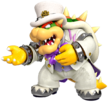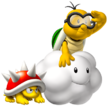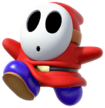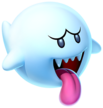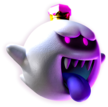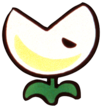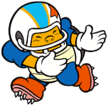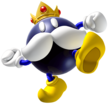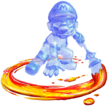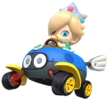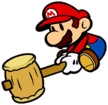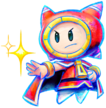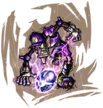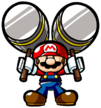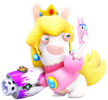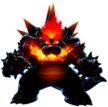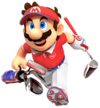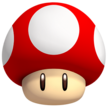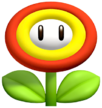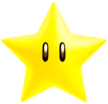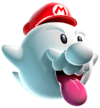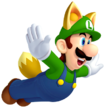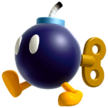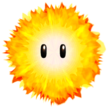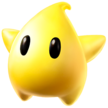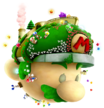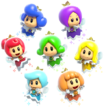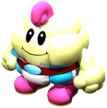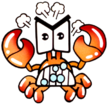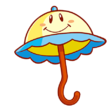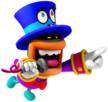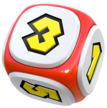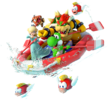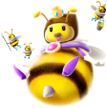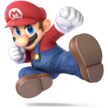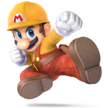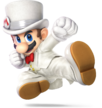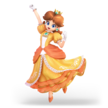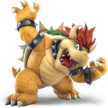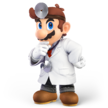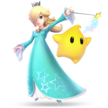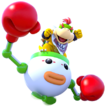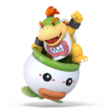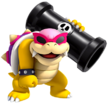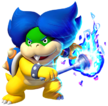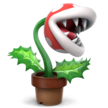| Spirit
|
Battle parameters |
Inspiration
|
| No.
|
Image
|
Name
|
Enemy Fighter(s)
|
Type
|
Power
|
Stage
|
Rules
|
Conditions
|
Music
|
| 20
|
|
Super Star
|
•Rosalina & Luma 
|
|
9,200
|
Peach's Castle
|
•Attack Power ↑
•Temporary Invincibility
•Item: Super Star
|
•The enemy will occasionally be invincible when the enemy's at high damage
•All fighters are easy to launch
•The enemy's FS Meter charges quickly
|
Main Theme - Super Mario 64
|
Spirit Battle inspiration:
- The yellow Rosalina's star-patterned dress and the yellow Luma's design represent the Super Star, a yellow star-shaped item with simple black eyes, which appears as the item.
- The yellow Rosalina & Luma reference Rosalina's association with stars in the Mario series, serving as the mother of Lumas, a star-shaped species that resembles the Super Star.
- The yellow Rosalina & Luma and the stage reference their respective appearance in Super Mario Galaxy and Super Mario 64, both of which feature the Power Stars, a collectible goal item resembling the Super Star.
- The music track represents the theme song played on Bob-omb Battlefield, the first course in Super Mario 64 featuring the game's first Power Star.
- The Temporary Invincibility rule references the Super Star's ability to grant the player temporary invincibility when collected, which also gives them a bright, sparkling appearance.
- The Attack Power ↑ and Easy to Launch rules reference the Super Star's ability to grant the player the ability to easily defeat enemies by running into them and knocking them off-screen.
- Rosalina & Luma's Grand Star Final Smash represents the Grand Star, the larger and more powerful version of the Power Stars in Super Mario Galaxy resembling the Super Star.
Other trivia:
- This spirit's Support and Shield types reference the Super Star's role in the Super Mario series as a protective power-up item.
- This spirit's Shield type and First-Strike Advantage ability reference the Super Star's ability to protect the player from taking damage, which also gives them a bright, sparkling appearance.
- In World of Light, the Super Star spirit is located in the eastern cloudy area in the Light Realm similar to the stage's cloudy sky setting.
|
| 21
|
|
Metal Mario
|
•Metal Mario 
|
|
9,600
|
The Great Cave Offensive (Battlefield form)
|
N/A
|
•The enemy is slow but has increased defense and attack
•The enemy is metal
|
Metal Battle
|
Spirit Battle inspiration:
- The black Metal Mario represents Metal Mario, the dark, metallic power-up form of Mario which can obtained after breaking the Metal Box.
- The stage represents the Cavern of the Metal Cap, a cavernous stage featuring crystals where the Metal Mario power-up form can be first obtained in Super Mario 64.
- The stage represents Meta Crystal, a stage based on Cavern of the Metal Cap featured in Super Smash Bros.'s 1P Game mode which features the Metal Mario mini-boss battle.
- The stage's Battlefield form and the music track represent the Battlefield stage featured in Super Smash Bros. Melee's Adventure Mode which features the Metal Mario mini-boss battle.
- The first battle condition references Metal Mario's increased offense and defense stats, and decreased speed and mobility stats in his game appearances.
Other trivia:
- This spirit's Shield type references Metal Mario's increased defense stats, which features increased resistance to enemy attacks.
- This spirit's Weight ↑ ability references Metal Mario's increased weight stats and decreased speed and mobility stats.
|
| 22
|
|
Boo Mario
|
•Mario 
|
|
1,900
|
Dracula's Castle (hazards off)
|
•Hazard: High Gravity
•Hazard: Low Gravity
•Invisibility
|
•The enemy is invisible
•Your jumping power decreases when the enemy's at high damage
•The enemy is less affected by gravity
|
Castle / Boss Fortress - Super Mario World / SMB 3
|
Spirit Battle inspiration:
- The black Mario represents Boo Mario, the ghost-like Boo Mushroom power-up form of Mario featuring his physical facial traits and his hat.
- The stage represents the haunted mansion in the Ghostly Galaxy, a ghost-themed galaxy featured in Super Mario Galaxy where the Boo Mario power-up form can be first obtained.
- The stage and music track represent the Ghost House stages in Super Mario World and World 2-Fortress in Super Mario Bros. 3, both featuring Boo as an enemy, who serves as the basis of the Boo Mario power-up form.
- The music track features the Ghost House theme song in Super Mario World, which is used for the Boo Moon Galaxy stage in Super Mario Galaxy 2 where the Boo Mario power-up form can be obtained.
- The Invisibility rule references the Boo's ability to turn invisible and Boo Mario's ability to turn invisible and intangible, which allows him to pass through certain walls and grates.
- The Low Gravity and High Gravity hazards reference the Boo's ability to float in the air and Boo Mario's ability to levitate higher while floating in midair.
Other trivia:
- This spirit's Support type references how the Boo Mario power-up form can help Mario collect the Power Stars in Super Mario Galaxy.
- This spirit's Shield type references Boo Mario's ability to turn invisible and intangible, which allows him to be protected from any obstacle or enemy damage.
- This spirit's Lightweight ability further references Boo Mario's ability to float in the air and levitate higher while floating in midair.
|
| 23
|
|
Rock Mario
|
•Metal Jigglypuff 
|
|
4,200
|
Mario Galaxy (Battlefield form)
|
N/A
|
•The enemy's neutral special has increased power
•The enemy favors neutral specials
•The enemy is metal
|
Melty Monster
|
Spirit Battle inspiration:
- The blue Metal Jigglypuff represents Rock Mario, the rock-like Rock Mushroom power-up form of Mario which allows him to transform into a spherical, hard-shelled boulder.
- The stage's Battlefield form represents the starting planet of the Boulder Bowl Galaxy, a semispherical planet where the Rock Mario power-up form can be first obtained in Super Mario Galaxy 2.
- The music track represents the theme song played on the Melty Monster Galaxy, a lava-filled galaxy featured in Super Mario Galaxy 2 where the Rock Mario power-up form can be obtained.
- Jigglypuff's favored Rollout references Rock Mario's ability to transform into his spherical boulder form and roll at high speeds, which is capable of damaging any enemy.
- Jigglypuff's Rollout is based on the Rock-type move used by spherical Pokémon, further referencing the spherical, hard-shelled appearance of Rock Mario's boulder form and ability to roll and damage enemies.
Other trivia:
- This spirit's Support type references how the Rock Mario power-up form can help Mario collect the Power Stars in Super Mario Galaxy 2.
- This spirit's Shield type and Physical Attack ↑ ability further references Rock Mario's ability to transform into his boulder form, which is capable of preventing him from taking damage from certain hazards and damaging enemies along the way.
|
| 25
|
|
Fox Luigi
|
•Tail Luigi 
|
|
9,300
|
Mushroom Kingdom U
|
•Hazard: Heavy Wind
|
•Dangerously high winds are in effect
|
Ground Theme - Super Mario Bros. 3 (Remix)
|
Spirit Battle inspiration:
- The yellow Tail Luigi represents Fox Luigi, the foxlike Super Leaf power-up form of Luigi which gives him yellow fox ears and a fox tail.
- The stage represents the main setting of New Super Mario Bros. U, the follow-up game to New Super Mario Bros. 2 which first features the Fox Luigi power-up form.
- The stage represents the main setting of New Super Mario Bros. U, featuring the Flying Squirrel power-up form which features a similar gameplay with the Super Leaf power-up forms.
- The music track represents the ground theme song played during World 1-1 in Super Mario Bros. 3 where the Super Leaf power-up form can be first obtained.
- The Heavy Wind hazard references the Super Leaf power-up form's ability to fly and glide across the stage, which can be extended after filling up the Power Meter by running.
- Luigi's Fireball references how Fox Luigi is based on a kitsune, a mythical fox creature in Japanese mythology that is known for generating glowing fireballs.
Other trivia:
- This spirit's Support type references how the Fox Luigi power-up form can help Luigi clear stages in the Super Mario series.
- This spirit's Shield type and Easier Dodging ability reference Fox Luigi's Tanooki Suit power-up form equivalent, Kitsune Luigi, which allows him to transform into a statue and become immune to enemy attacks.
|
| 26
|
|
Flying Squirrel Toad
|
•Tail Mii Swordfighter  (Moveset 2123, Super Mushroom Hat, Monkey Suit, High Voice Type 8) (Moveset 2123, Super Mushroom Hat, Monkey Suit, High Voice Type 8)
|
|
3,700
|
Mushroom Kingdom U (Ω form)
|
N/A
|
•The enemy favors down specials in the air
•The enemy has increased jump power
|
Ground Theme - New Super Mario Bros. U
|
Spirit Battle inspiration:
- The Tail Mii Swordfighter represents Flying Squirrel Toad, the Super Acorn power-up form of Toad which features a similar gameplay with the Super Leaf power-up forms.
- The Tail Mii Swordfighter's Super Mushroom Hat represents Toad's cap, the Monkey Suit represents Flying Squirrel Toad's yellow torso, and the high voice type represents Toad's high-pitched voice.
- The stage and music track represent Acorn Plains, the first stage in New Super Mario Bros. U where the Flying Squirrel power-up form can be first obtained.
- The "increased jump power" battle condition references the Flying Squirrel Jump, a technique used by the Flying Squirrel power-up form which allows the user to propel themselves upwards while flying in midair.
- The Mii Swordfighter's favored Power Thrust features the airborne Mii Swordfighter launching at a downward angle, referencing the Flying Squirrel power-up form's ability to descend downwards at an angle while gliding in the air.
Other trivia:
- This spirit's Grab type and Toss & Meteor ability reference Toad's ability to pluck items from the ground and throw them in his playable appearances in the Mario series.
- This spirit's Grab type and Toss & Meteor ability also reference Toad's appearance in Super Smash Bros. Ultimate, serving as part of Peach and Daisy's grab-and-throw attacks.
|
| 27
|
|
Baby Peach
|
•Tiny Isabelle 
•Mario 
|
|
3,600
|
Princess Peach's Castle
|
N/A
|
•Defeat the main fighter to win
•The enemy favors dash attacks
•The enemy has increased move speed
|
Ground Theme - Super Mario Bros. (Melee)
|
Spirit Battle inspiration:
- The pink Tiny Isabelle represents Baby Peach, the infant counterpart of Princess Peach who features blonde hair and wears a pink dress.
- The Striped Mario minion references his appearance as the series' titular main playable character, who befriends Baby Peach in Mario & Luigi: Partners in Time.
- The stage and music track represent Princess Peach's Castle, the landmark castle location featured in Partners in Time where Baby Peach resides in the past.
- The first battle condition references Mario's role in Partners in Time to travel to the past with Luigi and protect Baby Peach and their infant counterparts from the invading Shroob forces.
- The "increased move speed" battle condition references Baby Peach's first playable appearance in Mario Kart Wii, who features a high acceleration stat.
- Mario's favored dash attack is based on a baseball slide, referencing Mario Super Sluggers, a Mario-themed baseball game featuring Baby Peach as a playable character.
- Isabelle falls slowly, referencing Princess Peach's ability to temporarily hover in the air using her Floating Jump ability or her parasol in her playable game appearances.
Other trivia:
- This spirit's Support type references Baby Peach's supportive role in her game appearances in Mario & Luigi: Partners in Time and Yoshi's Island DS.
- This spirit's Air Defense ↑ ability further reference Princess Peach's ability to hover and glide in the air using her parasol, which can also be used to defend her from enemy attacks.
|
| 29
|
|
Peach (Wedding)
|
•Peach 
•Mario 
|
|
9,900
|
New Donk City Hall
|
•Flowery
|
•Defeat the main fighter to win
•You constantly take minor damage
•The enemy tends to avoid conflict
|
Break Free (Lead The Way)
|
Spirit Battle inspiration:
- The white Peach references her appearance as the damsel-in-distress of Super Mario Odyssey, who is kidnapped by Bowser and forced to marry him.
- Peach's white costume is based on a wedding gown, referencing the Lochlady Dress, a white wedding dress that Princess Peach wears for her forced marriage.
- The Wedding Mario minion references his appearance as the main playable character of Odyssey, who rescues Princess Peach while wearing the Wedding Top Hat and Tuxedo.
- The stage represents the New Donk City Hall in Odyssey where Bowser's airship can be seen flying above the top of the city hall's rooftop holding Princess Peach hostage.
- The music track represents "Break Free (Lead the Way)", which plays during the escape sequence in Odyssey where Mario captures an unconscious Bowser and quickly escapes the collapsing moon with Peach.
- The Flowery rule references the bouquet of flowers held by the bride during weddings, as well as the Burst Flower and the bouquet of Piranha Plants offered to Peach by Mario and Bowser respectively.
- The puppet fighters starting off with increased move speed and the battle conditions reference Mario's role in the titular series to protect Peach from Bowser, which Mario fails at during the opening cutscene of Odyssey.
Other trivia:
- This spirit's Support type references Peach's role in the post-game of Odyssey by providing Mario with a Power Moon in each kingdom.
- This spirit's Shield type references Peach's role in the Mario series as the damsel-in-distress, whom Mario must rescue and protect from Bowser.
- This spirit's Critical-Health Healing ability references how Mario was injured during Peach's kidnapping in the beginning Odyssey, but later recovers to rescue her.
- In World of Light, the Wedding Peach spirit is featured on Galeem's side of the Final Battle map while the Wedding Bowser spirit is featured on Dharkon's side, referencing how both characters are the wedding forms of Peach and Bowser respectively.
|
| 30
|
|
Bowser (Wedding)
|
•Bowser 
•Ally: Peach 
|
|
9,700
|
New Donk City Hall
|
N/A
|
•You lose if your CPU ally is KO'd
•The enemy favors dash attacks
•The enemy has increased attack power
•The enemy has increased move speed
|
Underground Moon Caverns
|
Spirit Battle inspiration:
- The grey Bowser references his appearance as the main antagonist of Super Mario Odyssey, who wears a white wedding tuxedo featuring a spiky design.
- The white Peach ally references her appearance as the damsel-in-distress of Super Mario Odyssey, who is kidnapped by Bowser and forced to marry him.
- The Peach ally's white costume is based on a wedding gown, referencing the Lochlady Dress, a white wedding dress that Princess Peach wears for her forced marriage.
- The stage represents the New Donk City Hall in Odyssey where Bowser can be seen aboard his airship flying above the city hall's rooftop while the Mechawiggler absorbs the city's electricity.
- The music track represents the theme song played in the underground caverns of the Moon Kingdom where Bowser attempts to forcibly marry Princess Peach in the kingdom's Wedding Hall.
- The first battle condition references Mario's role in Odyssey to quickly rescue Peach from being forcibly married to Bowser after failing to prevent her kidnapping during the opening cutscene.
- Bowser's favored dash attack references the ending cutscene of Odyssey where Bowser bumps Mario away while offering a Burst Flower to Peach so he could offer her a bouquet of Piranha Plants.
- Bowser starts off with increased move speed, referencing the aftermath of Bowser's final boss battle in Odyssey where Mario captures an unconscious Bowser and quickly escapes the collapsing moon with Peach.
Other trivia:
- This spirit's Grab type references Bowser's role in the Mario series as the main antagonist, who often kidnaps Princess Peach and holds her hostage.
- In World of Light, the Wedding Bowser spirit is featured on Dharkon's side of the Final Battle map while the Wedding Peach spirit is featured on Galeem's side, referencing how both characters are the wedding forms of Bowser and Peach respectively.
|
| 31
|
|
Toad
|
•Mii Brawler  (Moveset 1331, Super Mushroom Hat, Blue - Toad Outfit, High Voice Type 8) (Moveset 1331, Super Mushroom Hat, Blue - Toad Outfit, High Voice Type 8)
|
|
3,600
|
Princess Peach's Castle
|
•Item: Mushrooms
|
•The enemy favors side specials
|
Plucky Pass Beginnings
|
Spirit Battle inspiration:
- The Mii Brawler's costume represents Toad, a member of the Toad species in the Mario series featuring a mushroom-shaped head.
- The Mii Brawler's Super Mushroom Hat represents Toad's cap, the blue Toad Outfit represents Toad's blue outfit used in his later in-game appearances, and the high voice type represents Toad's high-pitched voice.
- The stage represents Princess Peach's Castle, the landmark castle location of the Mushroom Kingdom in the Mario series where Toad serves as the kingdom's dominant species and as Princess Peach's attendant.
- The stage represents Princess Peach's Castle, the main hub area of Super Mario 64 featuring the Toad's first three-dimensional appearance in the Mario series.
- The music track represents the theme song played on Plucky Pass Beginnings, the first stage of Captain Toad: Treasure Tracker featuring Captain Toad as the main playable character.
- The Super Mushroom and Poison Mushroom items reference the Toad species' mushroom-shaped heads, which resemble the Super Mushroom and the Poison Mushroom.
- The Mii Brawler's favored Suplex references Toad's ability to pluck items from the ground and throw them in his playable appearances in the Mario series.
Other trivia:
- This spirit's Grab type further references Toad's ability to pluck items and throw items in his playable appearances in the Mario series.
|
| 33
|
|
Toadette
|
•Villager 
•Mii Brawler  (Moveset 2231, Toad Hat, Toad Outfit, High Voice, Type 7) (Moveset 2231, Toad Hat, Toad Outfit, High Voice, Type 7)
|
|
2,600
|
The Great Cave Offensive (Battlefield form)
|
N/A
|
•The enemy is easily distracted by items
|
Plucky Pass Beginnings
|
Spirit Battle inspiration:
- The pink female Villager represents Toadette, a female Toad wearing a pink-and-white-spotted cap on her head.
- The Mii Brawler minion's costume and high voice type represent Toad, a member of the Toad species who serves as Toadette's partner in the Mario series, starting with Mario Kart: Double Dash!!
- The Mii Brawler minion's Toad Hat represents Toad's cap, the Toad Outfit represents Toad's blue outfit used in his later in-game appearances, and the high voice type represents Toad's high-pitched voice.
- The Mii Brawler minion and the music track represent Captain Toad, the main playable character of Captain Toad: Treasure Tracker which also features Toadette as a main playable character.
- The stage represents Mine Cart Tunnel Throwdown, an underground cavern stage in Captain Toad: Treasure Tracker featuring an underground setting and minecarts similar to the stage's normal form.
- The stage represents The Great Cave Offensive in Kirby Super Star, which features explorable areas and hidden treasure similar to Captain Toad: Treasure Tracker.
- The battle condition references Captain Toad and Toadette's occupation as treasure hunters in Captain Toad: Treasure Tracker, where they collect different objects and items to progress through different stages.
- The Mii Brawler's Head-On Assault references Toad's appearance in Super Smash Bros. Ultimate, who serves as Peach and Daisy's down throw attack where Toad headbutts the opponent into the ground.
Other trivia:
- In World of Light, the Toadette spirit is located at the ruins in the shrouded forest area in the Light Realm, similar to the stage's underground setting.
|
| 34
|
|
Toadsworth
|
•Mario 
|
|
1,900
|
Princess Peach's Castle
|
•Item: Mushrooms
|
•Take your strongest team into this no-frills battle
|
Ricco Harbor
|
Spirit Battle inspiration:
- The Builder Mario represents Toadsworth, an elderly mustached Toad wearing a large pale yellow cap on his head.
- The stage represents Princess Peach's Castle, the landmark castle location of the Mushroom Kingdom in the Mario series where Toadsworth serves as Princess Peach's attendant and longtime steward.
- The music track represents the theme song played on Ricco Harbor, a construction zone area featured in Super Mario Sunshine which first features Toadsworth as an ally.
- The Super Mushroom and Poison Mushroom items reference how Toadsworth is a member of the Toad species, whose mushroom-shaped heads resemble the Super Mushroom and the Poison Mushroom.
Other trivia:
- This spirit's Support type references Toadsworth's loyalty to Princess Peach and alliance with the Mario Bros. in the Mario series.
- This spirit's Ramblin' Evil Mushroom Equipped ability further references Toadsworth's Toad species, whose mushroom-shaped heads resemble the Ramblin' Evil Mushroom.
|
| 35
|
|
Waluigi
|
•Luigi 
|
|
9,200
|
Peach's Castle
|
•Assist Trophy Enemies (Waluigi)
|
•Hostile assist trophies will appear
|
Waluigi Pinball - Mario Kart DS
|
Spirit Battle inspiration:
- Luigi's purple costume is based on Waluigi, the evil counterpart of Luigi who appears as the Assist Trophy enemy.
- The stage represents Peach Court, a tennis court located outside of Peach's Castle in Mario Tennis which first features Waluigi as a playable character.
- The stage may represent the Waluigi Pinball race track from Mario Kart DS, due to it's layout resembling a pinball playfield
- The music track represents the Waluigi Pinball theme song, a race course featured in Mario Kart DS themed after Waluigi.
Other trivia:
- This spirit's Neutral type references Waluigi's status as an ally and enemy in the Mario series.
- This spirit's Foot Attack ↑ ability references Waluigi's powerful legs, which is used as his Assist Trophy ability to bury the summoner's opponents by stomping on them.
|
| 36
|
|
Goomba
|
•Tiny Donkey Kong Team  ×5 ×5
|
|
1,800
|
Mushroom Kingdom (Battlefield form)
|
N/A
|
•Defeat an army of fighters
|
Ground Theme - Super Mario Bros.
|
Spirit Battle inspiration:
- The red Tiny Donkey Kong represents the Goomba, a small, brown mushroom enemy featuring scowling eyes who appears in groups.
- The stage and music track represent World 1-1, the first stage of Super Mario Bros. which first features the Goomba as an enemy.
Other trivia:
- This spirit's Neutral type references the Goomba's role as one of Mario's allies or Bowser's minions in the Mario series.
- This spirit's Foot Attack ↑ ability references how the Goomba can be defeated by a jump attack in the Mario series.
|
| 37
|
|
Koopa Troopa
|
•Squirtle 
|
|
1,700
|
Golden Plains
|
•Defense ↑
•Item Tidal Wave
•Item: Green Shell
|
•The enemy has increased defense after a little while
•Certain items will appear in large numbers
•The enemy is easily distracted by items
|
Main Theme - New Super Mario Bros.
|
Spirit Battle inspiration:
- The green Squirtle starting with a Green Shell represents the Koopa Troopa, a turtle-like enemy who commonly features a green shell.
- The stage and music track represent World 1-1, the first stage of New Super Mario Bros. 2, which features the Koopa Troopa as an enemy.
- The Green Shell item represents the green Koopa Troopa shell, which acts as an item that can be carried, hit, or thrown after hitting the Koopa Troopa with a jump attack.
- The Defense ↑ rule references how the Koopa Troopa cannot be defeated by a jump attack in the Mario series, instead retreating into their shells until they reemerge.
Other trivia:
- This spirit's Support type references the Koopa Troopa's role as one of Bowser's minions in the Mario series.
- This spirit's Grab type references the green color scheme of the Koopa Troopa's shell.
- This spirit's Grab type and Green Shell Equipped ability reference how Koopa Troopa shells can be grabbed and used as an item in Super Mario Bros. 3.
|
| 38
|
|
Hammer Bro
|
•Yoshi 
|
|
3,400
|
Golden Plains (Battlefield form)
|
•Assist Trophy Enemies (Hammer Bro)
|
•Hostile assist trophies will appear when the enemy's at high damage
•The enemy favors up specials
|
Ground Theme - Super Mario Bros. 3 (Remix)
|
Spirit Battle inspiration:
- The yellow Yoshi represents Hammer Bro, a yellow reptilian enemy who appears as the Assist Trophy enemy.
- The stage represents World 1-1, the first stage of New Super Mario Bros. 2 which features the Hammer Bro as an enemy.
- The music track represents the ground theme song of Super Mario Bros. 3, which features the Hammer Bro as an enemy.
- The Hammer Bro Assist Trophy enemy appears when Yoshi reaches 50% damage, referencing how the Hammer Bro appears in groups in the Mario series.
- Yoshi's favored Egg Throw references the Hammer Bro's ability to attack the player by throwing their hammers while remaining stationary.
Other trivia:
- This spirit's Grab type references how the Hammer Bro. is often seen holding their hammers before throwing them.
- This spirit's Jump ↑ ability references the Hammer Bro's ability to jump, giving him a longer range to throw his hammers.
|
| 39
|
|
Lakitu & Spiny
|
•Iggy 
•Tiny Bowser  ×8 ×8
|
|
3,400
|
Mushroom Kingdom
|
N/A
|
•Defeat an army of fighters
|
Ground Theme - Super Mario Bros.
|
Spirit Battle inspiration:
- Iggy Koopa represents Lakitu, a bespectacled Koopa enemy who commonly features a green shell.
- Iggy Koopa's Koopa Clown Car represents the Lakitu Cloud, a faced white cloud piloted by Lakitu capable of hovering above the ground.
- The red Tiny Bowser minions represent the Spinies, a small quadruped Koopa featuring a red spiked shell who appears in groups.
- The stage and music track represent World 4-1, the fourth world in Super Mario Bros. which first features the Lakitu and Spinies as enemies.
Other trivia:
- This spirit's Grab type references how the Lakitu is often seen grabbing and holding a Spiny Egg before throwing it.
- This spirit's Weight ↓ ability references how the Lakitu is often floating around in their Lakitu Clouds.
- In World of Light, the Lakitu & Spiny spirit is located on a green pipe from the Mario universe in the Mysterious Dimension map in the Dark Realm.
|
| 40
|
|
Blooper
|
•Tiny Inkling  ×3 ×3
|
|
2,600
|
Delfino Plaza (Battlefield form)
|
•Hazard: Low Gravity
|
•Timed battle (1:30)
•Gravity is reduced
•The enemy tends to avoid conflict
|
Underwater Theme - Super Mario Bros.
|
Spirit Battle inspiration:
- The cyan Tiny Inkling represent the Blooper, a small, white squid enemy featuring black markings around its eyes who appears in groups.
- The stage represents Isle Delfino, the main hub area of Super Mario Sunshine featuring the Blooper's first three-dimensional appearance in the Mario series.
- The music track represents the underwater stage theme song of Super Mario Bros. which first features the Blooper as an enemy.
- The Low Gravity hazard references the swimming gameplay mechanic in the Mario series, where the players can quickly swim upwards and fall slowly underwater.
- The Low Gravity hazard and third battle condition reference the Blooper's erratic swimming patterns while underwater in the Mario series' underwater stages.
Other trivia:
- This spirit's Shield type references how the Bloopers cannot be defeated under normal circumstances while underwater.
- This spirit's Weight ↓ ability reference how the Bloopers are lightweight swimmers in the Mario series' underwater stages.
- In World of Light, the Blooper spirit is located in the eastern coastal town area in the Light Realm, similar to the stage's setting.
|
| 41
|
|
Bullet Bill
|
•Captain Falcon Team  ×4 ×4
|
|
1,800
|
Mushroom Kingdom
|
•Item Tidal Wave
•Item: Bullet Bill
|
•Certain items will appear in large numbers
•The enemy is easily distracted by items
|
Airship Theme - Super Mario Bros. 3
|
Spirit Battle inspiration:
- The black Captain Falcon represents the Bullet Bill, a black bullet-like enemy appearing in groups, which appears as the item.
- The stage represents World 5-1, the fifth world of Super Mario Bros. which first features the Bullet Bill as an enemy.
- The music track represents the airship stage theme song in Super Mario Bros. 3, which features the Bullet Bill as an enemy.
- The Bullet Bill item's ability and the battle conditions reference how multiple Bullet Bills can be shot out of their Bill Blasters towards the player at high speeds.
Other trivia:
- This spirit's Attack type references how Bullet Bills attack by shooting at the player from the Bill Blasters.
- In World of Light, the Bullet Bill spirit is located in the eastern 8-bit maze area in the Light Realm, referencing how the Bullet Bill debuted as an 8-bit character.
|
| 43
|
|
Shy Guy
|
•Mii Brawler  (Moveset 1311, Shy Guy Mask, Standard Outfit, Red Outfit Color, Low Voice Type 7) (Moveset 1311, Shy Guy Mask, Standard Outfit, Red Outfit Color, Low Voice Type 7)
•Tail Mii Gunner  (Moveset 3312, Shy Guy Mask, Standard Outfit, Red Outfit Color, Low Voice Type 7) (Moveset 3312, Shy Guy Mask, Standard Outfit, Red Outfit Color, Low Voice Type 7)
•Mii Swordfighter  (Moveset 1332, Shy Guy Mask, Standard Outfit, Red Outfit Color, Low Voice Type 7) (Moveset 1332, Shy Guy Mask, Standard Outfit, Red Outfit Color, Low Voice Type 7)
|
|
1,500
|
Mushroom Kingdom II (Battlefield form)
|
•Item: Throwing Types
|
•The enemy favors neutral specials
•The enemy is easily distracted by items
|
Ground Theme - Super Mario Bros. 2
|
Spirit Battle inspiration:
- The Mii Fighters' costumes represent the Shy Guy, a humanoid enemy featured in the Mario series who appears in groups.
- The Mii Fighters' Shy Guy Mask and red Standard outfit represent the Shy Guy's mask and red cloak, and the low voice type represent the Shy Guy's deep voice.
- The Tail Mii Gunner minion represents the Fly Guy, a variation of the Shy Guy who uses a propeller attached to their heads to fly and hover in the air.
- The stage and music track represent World 1-1, the first world of Super Mario Bros. 2, which first features the Shy Guy as an enemy.
- The Mii Swordfighter's Chakram and the Throwing Type items reference how the Shy Guys can be defeated by throwing them or throwing objects at them in Super Mario Bros. 2.
- The Mii Brawler's Shot Put references the Snifits, a variation of the Shy Guy wearing a mask which can shoot black metallic bullets from the nozzle.
- The Mii Gunner's Grenade Launch references the Autobomb, a wheeled cannon piloted by the Shy Guy which can shoot fiery projectiles in Super Mario Bros. 2.
Other trivia:
- This spirit's Neutral type references the Shy Guy's role as one of Mario's allies or Bowser's minions in the Mario series.
- This spirit's Fist Attack ↑ ability references the Shy Guy's appearance as an enemy in Super Smash Bros for 3DS's Smash Run where they will charge and punch the player.
- In World of Light, the Shy Guy spirit is located in the hillside of the western hill area in the Light Realm, similar to the stage's hillside setting.
|
| 44
|
|
Pidgit
|
•Peach 
|
|
3,600
|
Mushroom Kingdom II
|
N/A
|
•The enemy starts the battle with a Rocket Belt
•The enemy has increased jump power
|
Ground Theme - Super Mario Bros. 2
|
Spirit Battle inspiration:
- The black Peach represents Pidgit, a black crow-like enemy whose magical flying carpet features a similar floating ability similar to Peach.
- The black Peach references her appearance as one of the main playable characters featured in her playable debut game, Super Mario Bros. 2.
- The stage and music track represent World 1-2, the second stage of Super Mario Bros. 2 which first features Pidgit as an enemy, who appears as a stage hazard.
- Peach starting off with a Rocket Belt and the "increased jump power" battle condition references the Pidgit's usage of the magical flying carpet, which allows it to fly upwards and hover in the air.
Other trivia:
- This spirit's Support type references the Pidgit's role as one of Wart's minions in Super Mario Bros. 2.
- This spirit's Support type references how the player can use the Pidgit's magic carpet to soar in the air for short distances in Super Mario Bros. 2.
- This spirit's Air Attack ↑ ability references the Pidgit's ability to swoop down with their magic carpet and attack the player in Super Mario Bros. 2.
- In World of Light, the Pidgit spirit is located on a green pipe from the Mario universe in the Mysterious Dimension map in The Dark Realm.
|
| 46
|
|
Mouser
|
•Pikachu 
|
|
2,000
|
Mushroom Kingdom II (Battlefield form)
|
•Item: Bob-omb
|
•The enemy is easily distracted by items
•The enemy starts the battle with a Bob-omb
|
Boss Theme - Super Mario Bros. 2
|
Spirit Battle inspiration:
- The Glasses Pikachu's costume features the Wide-Frame Glasses, representing Mouser, a mouse-like enemy wearing a pair of wide-frame sunglasses.
- The stage and music track represent World 1-3, the third stage of Super Mario Bros. 2, which first features Mouser as a boss.
- The Bob-omb item represents the bombs featured in Mouser's boss battles in Super Mario Bros. 2, which can be carried, thrown, and will blink red before exploding.
- The first battle condition references Mouser's boss battles in Super Mario Bros. 2 where Mouser will collect and throw the bombs at the player.
Other trivia:
- This spirit's Grab type references the boss battles against Mouser in Super Mario Bros. 2 where Mouser grabs and throws his bombs, which the player can grab and throw back and damage him.
- This spirit's Grab type references the grabbing gameplay mechanic of Super Mario Bros. 2, which can be used to grab and throw the bombs back at Mouser during his boss battles.
|
| 47
|
|
Wart
|
•King K. Rool 
•Peach 
|
|
4,000
|
Skyworld (Battlefield form)
|
•Hazard: Slumber Floor
|
•Defeat the main fighter to win
•The floor is sleep-inducing
|
Boss Theme - Super Mario Bros. 2
|
Spirit Battle inspiration:
- The blue King K. Rool represents Wart, the reptilian main antagonist of Super Mario Bros. 2 who features an oversized gut and wears a royal crown and cape.
- The white Peach minion's Vegetable represents the Dream Machine, a device which can produce vegetables that can be carried and thrown at Wart.
- The white Peach minion references her appearance as one of the main playable characters featured in her playable debut game, Super Mario Bros. 2.
- The stage represents World 7 in the Super Mario All-Stars version of Super Mario Bros. 2, taking place in a sky area with cloud platforms and temples in the background.
- The stage and music track represent World 7-2 in Super Mario Bros. 2, which takes place in a sky temple and features Wart as the game's final boss.
- The Slumber Floor hazard references the dream world of Subcon, the main setting of Super Mario Bros 2 taken over by Wart, which is revealed to take place in Mario's dream while he sleeps.
Other trivia:
- This spirit's Grab type references Wart's role in Super Mario Bros. 2 as the game's main antagonist, who takes over the dream world of Subcon.
- This spirit's Grab type references the grabbing gameplay mechanic of Super Mario Bros. 2, which can be used to grab and throw the vegetables back at Wart during his boss battle.
- In World of Light, the Wart spirit is located in the eastern cloudy area in the Light Realm, further referencing the Sky, which serves as the final world of Super Mario Bros. 2.
|
| 48
|
|
Boo
|
•Kirby 
|
|
1,800
|
Mushroom Kingdom U (Slide Lift Tower)
|
•Invisibility
|
•The enemy is invisible
•The enemy's shield has extra durability
|
Main Theme - Luigi's Mansion (Brawl)
|
Spirit Battle inspiration:
- The white Kirby represents Boo, a white ghost-like enemy with a spherical body and stubby arms who features the ability to float in the air.
- The stage represents World 2-Fortress in the Super Mario All-Stars version of Super Mario Bros. 3, taking place in a fortress with stone walls and barred windows which first features the Boo as an enemy.
- The music track represents the main theme song of Luigi's Mansion, the first installment of the titular game series which features the Boo as an enemy.
- The Invisibility rule references the Boo's shy personality, where they turn transparent and nearly invisible when faced by the player in the Mario series.
- Kirby's shielding and the second battle condition reference the Boo's ability to shield their face when faced by the player, and their inability to be defeated under normal circumstances
Other trivia:
- This spirit's Neutral type references the Boo's role as Mario's allies or Bowser's minions in the Mario series.
- In World of Light, the Boo spirit is located in the Dracula's Castle map in the Dark Realm, referencing the recurring Ghost enemies in the original Castlevania.
|
| 50
|
|
Bob-omb
|
•Kirby  ×3 ×3
|
|
3,500
|
Mushroom Kingdom
|
•Item: Bob-omb
|
•The enemy's throwing-type items have increased power
•The enemy has increased move speed
|
Airship Theme - Super Mario Bros. 3
|
Spirit Battle inspiration:
- The purple Kirby represent the Bob-omb, a dark, spherical, bomb-like enemy appearing in groups, which appears as the item.
- The stage represents the brick-like layout of World 3-3 in Super Mario Bros. 2, which first features the Bob-omb as an enemy.
- The music track represents the theme song played on the airship stages in Super Mario Bros. 3, which features the Bob-omb as an enemy.
- The first battle condition references how the Bob-omb can be used as a throwing item after being pulled up from the ground or attacked.
- The "increased move speed" battle condition references how the Bob-ombs will increase its walking speed and run after the player after being spotted in later Super Mario games.
Other trivia:
- This spirit's Support type references how the Bob-omb is used as Bowser's weapon in the Mario series.
- This spirit's Grab type and Bob-omb Equipped ability reference how the Bob-omb can be grabbed and carried around in the Mario series.
- This spirit is featured in the Sheldon's Place shop, which sells spirits related to weapons, referencing how the Bob-omb can be used as a weapon.
|
| 51
|
|
Chain Chomp
|
•Metal Pac-Man 
|
|
4,000
|
Yoshi's Island (Battlefield form)
|
•Assist Trophy Enemies (Chain Chomp)
|
•Hostile assist trophies will appear
•The enemy favors side specials
•The enemy is metal
|
Main Theme - Super Mario 64
|
Spirit Battle inspiration:
- The black Metal Pac-Man represents the Chain Chomp, a round, metallic, biting enemy who appears as the Assist Trophy enemy.
- The stage represents Yoshi's Island, the main setting of Super Mario World 2: Yoshi's Island featuring the Chain Chomp as an enemy, where two appear as background characters.
- The music track represents the theme song played on Bob-omb Battlefield, the first course in Super Mario 64 which features a single Chain Chomp as an enemy.
- The Chain Chomp Assist Trophy enemy often appears, referencing how the Chain Chomp appears in groups in the Mario series.
- Pac-Man's favored Power Pellet references the Chain Chomp's ability to attack the player by lunging at them and biting them while being held back by their chains.
- Pac-Man's favored Power Pellet features Pac-Man transforming into his classic form, which resembles the Chain Chomp's shape and biting attacks.
Other trivia:
- This spirit's Attack type further references the Chain Chomp's ability to attack by lunging at the player, where it will perform a powerful bite attack.
- This spirit's Weight ↑ ability references how the Chain Chomp is held back by its chain, which forces it to drop to the ground after lunging at the player
- This spirit is featured in the Timmy & Tommy's shop, which sells spirits related to items, referencing how the Chain Chomp can be used as an item in its in-game appearances.
|
| 53
|
|
Nipper Plant
|
•Tiny Pac-Man Team  ×8 ×8
|
|
1,900
|
Super Mario Maker (Battlefield form)
|
N/A
|
•The enemy loves to jump
•Defeat an army of fighters
|
Ground Theme - Super Mario Bros. 3 (Remix)
|
Spirit Battle inspiration:
- The white Tiny Pac-Man represents the Nipper Plant, a tiny, white plant-like enemy who appear in groups.
- The stage and music track represent World 5-1, the fifth world of Super Mario Bros. 3 which first features the Nipper Plant as an enemy.
- Pac-Man's Pac-Jump references the Nipper Plant's ability to jump and attack the player by biting them when they pass over them.
- Pac-Man's Pac-Jump features Pac-Man transforming into his classic form, which resembles the Nipper Plant's shape and biting attacks.
Other trivia:
- This spirit is featured in the Beedle's Tent shop, which sells spirits related to living creatures, referencing how the Nipper Plant is a sentient plant.
|
| 55
|
|
Boom Boom
|
•Giant Squirtle 
|
|
4,400
|
Unova Pokémon League (Battlefield form)
|
N/A
|
•The enemy has super armor and is hard to launch or make flinch
•The enemy can deal damage by dashing into you
•The enemy is giant
|
Fortress Boss - Super Mario Bros. 3
|
Spirit Battle inspiration:
- The red Giant Squirtle represents Boom Boom, a large Koopa enemy who features a red shell.
- The stage and music track represent the mini-fortress stages in Super Mario Bros. 3, which features Boom Boom as a mini-boss.
- The second battle condition references Boom Boom's ability to attack and damage the player by charging into them.
- Squirtle's crouching and the first battle condition reference how Boom Boom will crouch and retreat into his spiked shell when damaged by the player.
Other trivia:
- This spirit's Attack type references the red color scheme of Boom Boom's shell, and Boom Boom's usage of powerful attacks in his boss battles.
- In World of Light, the Boom Boom spirit is located at the entrance to the Molten Fortress map in the Light Realm, referencing Boom Boom's role to guard the fortress stages in the Mario series.
|
| 57
|
|
Tatanga
|
•Morton 
|
|
3,800
|
Mario Galaxy (Battlefield form)
|
N/A
|
•The enemy starts the battle with a Super Scope
|
Underground Theme - Super Mario Land
|
Spirit Battle inspiration:
- Morton Koopa represents Tatanga, a dark purple alien invader featuring fangs who is often seen piloting his hovering spacecraft.
- Morton Koopa's Koopa Clown Car represents the Pagosu, a hovering spaceship piloted by Tatanga equipped with an arsenal of weapons.
- The stage represents the second stage of the Space Zone in Super Mario 2: 6 Golden Coins, which features Tatanga as a boss.
- The music track represents the underground theme song of Super Mario Land, which first features Tatanga as the game's main antagonist.
- Morton starting off with a Super Scope, and the Ray Gun and Motion-Sensor Bomb items reference the weapons used by Tatanga during his boss battles, including lasers and scattered bombs.
Other trivia:
- This spirit's Shield type references Tatanga's spaceship, Pagosu, which protects him from most external attacks during his boss battles in the Super Mario Land series.
|
| 58
|
|
Hothead
|
•Curry Pac-Man 
|
|
2,000
|
Mushroom Kingdom U (Slide Lift Tower)
|
•Item: Hothead
|
•The enemy breathes fire
•The enemy is easily distracted by items
•The enemy starts the battle with a Hothead
|
Castle / Boss Fortress - Super Mario World / SMB 3
|
Spirit Battle inspiration:
- The yellow Curry Pac-Man represents the Hothead, a circular simple-eyed enemy made of fire, which appears as the item.
- The stage and the music track represent Wendy's Castle, the sixth castle stage in Super Mario World which first features the Hothead as an enemy.
- Pac-Man starting off with a Hothead and the Hothead item references how the Hothead enemy appears in groups in the Mario series.
Other trivia:
- This spirit's Support type references the Hothead's role as one of Bowser's minions in the Mario series.
- This spirit's Support and Grab types, and Hothead Equipped ability reference how the Hothead can be used as an item in the Super Smash Bros. series.
|
| 59
|
|
Chargin' Chuck
|
•Wario Team  ×4 ×4
|
|
1,800
|
Super Mario Maker (Battlefield form)
|
N/A
|
•The enemy favors dash attacks
|
Ground Theme - Super Mario World
|
Spirit Battle inspiration:
- The green Wario Team's helmet represents Chargin' Chuck, a large, muscular Koopa enemy wearing an American football helmet who appears in groups.
- The stage and music track represent Yoshi's Island 1, the first stage of the Yoshi's Island world in Super Mario World which first features Chargin' Chuck as an enemy.
- Wario's favored dash attack references Chargin' Chuck's ability to attack the player with a dashing tackle attack, which appears and behaves similarly to Wario's shoulder tackle attack.
Other trivia:
- This spirit's Attack type further references the Chargin' Chuck's ability to attack the player with a dashing tackle attack, which is powerful enough to destroy enemies and weaker obstacles in his in-game appearances.
|
| 60
|
|
Wiggler
|
•Yoshi 
|
|
1,600
|
Yoshi's Island (Melee)
|
•Attack Power ↑
•Item: Lip's Stick
|
•The enemy becomes powerful when badly damaged
|
Ground Theme - Super Mario World
|
Spirit Battle inspiration:
- The yellow Yoshi represents the Wiggler, a yellow-and-orange caterpillar enemy featuring a bulbous nose.
- The yellow Yoshi references his appearance as a playable character featured in his debut game, Super Mario World.
- The stage and music track represent Forest of Illusion 1, a forest stage featured in Super Mario World which first features the Wiggler as an enemy.
- The Lip's Stick item features a white flower that appears on top of the player's head when hit, referencing the white flower appearing on the top of the Wiggler's head.
- The Attack Power ↑ rule references how the Wiggler will become enraged after they are stomped on, which causes them to turn red and angrily pursue the player.
Other trivia:
- This spirit's Support type references the Wiggler's role as one of Bowser's minion in the Mario series.
- This spirit's Attack type further references how the Wiggler's power will increase after they are stomped on, which causes them to turn red.
- This spirit's Lip's Stick Equipped ability further references the white flower that grows on top of the Wiggler's head.
- In World of Light, the Wiggler spirit is located in the shrouded forest area in the Light Realm, referencing the Forest of Illusion, the fifth world in Super Mario World which first features the Wiggler as an enemy.
|
| 61
|
|
Kamek
|
•Inkling Team  ×4 ×4
|
|
3,300
|
Mushroom Kingdom U (Slide Lift Tower)
|
•Easy to Launch
•Item: Star Rod
|
•All fighters are easy to launch after a little while
•Reinforcements will appear after an enemy is KO'd
•The enemy starts the battle with a Star Rod
|
Fortress Boss - Super Mario World
|
Spirit Battle inspiration:
- The cyan Inkling represents Kamek, a Magikoopa enemy wearing thick eyeglasses and a cyan robe who appears in groups.
- The stage represents the Slide Lift Tower, a tower stage in New Super Mario Bros. U featuring the Magikoopa as the boss.
- The stage and the music track represent the Lemmy's Castle stage in Super Mario World, which first features the Magikoopa as an enemy.
- Inkling starting off with a Star Rod and the Star Rod item reference the magic scepter carried around by the Magikoopa, which they can use to attack the player by shooting damaging magical spells.
- The Easy to Launch rule and second battle condition reference how the Magikoopa can be easily defeated, but are immediately replaced with more Magikoopas that will appear out of thin air.
Other trivia:
- This spirit's Support type references Kamek's role as one of Bowser's minion in the Mario and Yoshi series.
- This spirit's Grab type references Kamek's role as a major antagonist in the Yoshi series who kidnaps the infant counterparts of different Mario characters or steals from the Yoshis.
- This spirit's Grab type and Magic Attack ↑ ability further reference the magic scepter carried around by Kamek, which he can use to attack the player by shooting damaging magical spells.
- In World of Light, the Kamek spirit is located in the Molten Fortress map, a Mario-themed dungeon in the Light Realm, referencing how the Magikoopas appear as enemies in the Mario series' castle stages.
- In World of Light, the Molten Fortress map's music track features the castle theme song of the castle stages featured in the Magikoopa's debut game, Super Mario World.
|
| 62
|
|
Mechakoopa
|
•Tiny Bowser Team  ×4 ×4
|
|
3,800
|
Mushroom Kingdom U (Slide Lift Tower)
|
N/A
|
•The enemy starts the battle with a Bob-omb
|
King Bowser - Super Mario Bros. 3
|
Spirit Battle inspiration:
- The yellow Tiny Bowser represents the Mechakoopa, the smaller, yellow mechanical versions of Bowser who appear in groups.
- The stage represents the Front Door and the Back Door stages of Bowser's Castle, the final stage in Super Mario World which first features the Mechakoopa as an enemy.
- The music track represents Bowser's final boss battle theme song in Super Mario Bros. 3, referencing how the Mechakoopa appears during Bowser's final boss battle in Super Mario World.
- Bowser starting off with a Bob-omb references the Mechakoopa's appearance in the Super Smash Bros. series as Bowser Jr.'s down special move where it will explode after colliding with another player.
Other trivia:
- This spirit's Support type references the Mechakoopa's role as one of Bowser's minion in the Mario series.
- This spirit's Grab type references how the Mechakoopa can be grabbed, carried around, and thrown after being hit with a jump attack in its in-game appearances.
- This spirit's Lava-Floor Resist ability references how the Mechakoopa cannot be destroyed when submerged into lava.
- In World of Light, the Mechakoopa spirit is located in the Molten Fortress map, a Mario-themed dungeon in the Light Realm, referencing how the Mechakoopa appear as enemies in the Mario series' castle stages.
- In World of Light, the Molten Fortress map's music track features the castle theme song of the castle stages featured in the Mechakoopa's debut game, Super Mario World.
|
| 63
|
|
Dry Bowser
|
•Bowser 
|
|
13,500
|
Reset Bomb Forest (Battlefield form)
|
•Defense ↑
•Curry-Filled
•Hazard: Lava Floor
|
•The floor is lava
•The enemy breathes fire after a little while
•The enemy has increased defense after a little while
|
King Bowser - Super Mario Bros. 3
|
Spirit Battle inspiration:
- The grey Bowser represents Dry Bowser, the undead skeletal version of Bowser featuring white bones and a black shell.
- The stage's Battlefield form represents World 8-Bowser's Castle, the final stage of New Super Mario Bros. taking place in a castle which features the first boss battle against Dry Bowser.
- The stage's Battlefield form and the Lava Floor hazard represent World 1-Castle, the first castle stage in New Super Mario Bros. where Bowser transforms into Dry Bowser after being submerged into the lava.
- The stage's Battlefield form and the Lava Floor hazard represent the lava-filled Castle stages in the Mario series, which features the boss battles against Dry Bowser.
- The music track represents Bowser's final boss battle theme song in Super Mario Bros. 3, referencing how Dry Bowser is the skeletal version of Bowser who also serves as a final boss in the Mario series.
- The Curry-Filled rule references Dry Bowser's signature Fire Breath attack, which was initially colored red-and-yellow in New Super Mario Bros.
- The Defense ↑ rule reference how Dry Bowser shares the Dry Bones enemy's abilities, including an immunity to Mario's fireball attacks and reviving after being damaged.
Other trivia:
- This spirit's Shield type further references how Dry Bowser shares the Dry Bones enemy's immunity to fire attacks and lava damage.
- This spirit's Fire Attack ↑ ability references how Dry Bowser is a more powerful version of Bowser, who is able to breathe powerful fireballs.
- In World of Light, the Dry Bowser spirit is located in the Dracula's Castle map in the Dark Realm, referencing the Dragon Skull Cannon enemies featured in the original Castlevania.
- In World of Light, the Dry Bowser spirit's specific placement in the Dracula's Castle map references Block 3 in the original Castlevania where the Dragon Skull Cannon debuted.
|
| 65
|
|
Big Urchin
|
•Giant Jigglypuff 
|
|
3,800
|
Mushroom Kingdom U (Battlefield form)
|
•Item: Unira
|
•The enemy is giant
•The enemy is easily distracted by items
|
Ground Theme / Underwater Theme - Super Mario 3D Land
|
Spirit Battle inspiration:
- The pink Giant Jigglypuff represents the Big Urchin, a giant variation of the purple Urchin enemy who features puffed cheeks and the ability to float.
- The stage represents the main setting of New Super Mario Bros. U which first features the Big Urchin as an enemy, who appears as a stage hazard in the stage's Rock-Candy Mines layout.
- The music track features the theme song of the underwater stages in Super Mario 3D Land, referencing how the Big Urchin serves as an enemy of the water stages in the Mario series.
- The Unira item represents the sea urchin enemy from Clu Clu Land similar to the Big Urchin, whose spines can damage the player on contact and prevent it from being damaged.
Other trivia:
- This spirit's Shield type further references the Big Urchin's spines, which prevents them from being defeated under normal circumstances.
- This spirit's Electric Weakness ability references how the Big Urchin resides in water, which serves as a conductor for electricity.
- This spirit is featured in the Beedle's Tent shop, which sells spirits related to living creatures, referencing how the Big Urchin is a sentient sea urchin.
|
| 66
|
|
King Bob-omb
|
•Giant Kirby 
|
|
4,100
|
Peach's Castle
|
•Item: Bob-omb
|
•The enemy is giant
•The enemy is easily distracted by items
|
Main Theme - Super Mario 64
|
Spirit Battle inspiration:
- The purple Giant Kirby represents King Bob-omb, the giant-sized king of the Bob-ombs who features a dark, spherical shape with bright simple eyes.
- The stage represents Princess Peach's Castle, the main hub area of Super Mario 64 which first features King Bob-omb as the game's first boss.
- The music track represents the theme song played on the Bob-omb Battlefield course, the first course in Super Mario 64 featuring King Bob-omb as a boss.
- The Bob-omb item and the second battle condition reference King Bob-omb's boss battle in Super Mario 64 DS where he will throw Bob-ombs at Yoshi without disguising himself as Mario, Luigi, or Wario.
Other trivia:
- This spirit's Strong Throw ability references King Bob-omb's boss battle in Super Mario 64 which involves King Bob-omb either throwing the player or getting thrown by the player.
|
| 67
|
|
Shine Sprite
|
•Rosalina & Luma 
•Kirby Team   
|
|
13,100
|
Delfino Plaza (roof)
|
•Temporary Invincibility
•Sudden Final Smash
•Item: Stars
|
•Defeat the main fighter to win
•The enemy will suddenly have a Final Smash
•The enemy will occasionally be invincible
|
Delfino Plaza (Remix)
|
Spirit Battle inspiration:
- The yellow Rosalina's star-patterned dress and the yellow Luma's design represent the Shine Sprite, a yellow star-themed entity with simple black eyes.
- The Kirby Team's yellow, red, and blue costumes each represent the three different types of Coins needed to collect a Shine Sprite: the Gold Coin, the Red Coin, and the Blue Coin.
- The stage's background features the Shine Gate, a giant monument centered with a giant effigy of a Shine Sprite where the smaller Shine Sprites gathered prior to the beginning of Super Mario Sunshine.
- The stage and music track represent Delfino Plaza, the main hub area of Sunshine taking place on Isle Delfino where the Shine Sprites serve as the game's main collectible goal item.
- The Temporary Invincibility rule features Rosalina with a bright and sparkling appearance, referencing the Shine Sprite's bright and sparkling appearance, serving as Isle Delfino's main source of sunlight in Sunshine.
- Rosalina & Luma's Grand Star Final Smash represents the Grand Star, the larger and more powerful version of the Power Stars in Super Mario Galaxy, which shares a similar appearance and role with the Shine Sprites.
- Rosalina & Luma's Grand Star Final Smash represents the giant effigy of the Shine Sprite in the middle of the Shine Gate where Shadow Mario's pollution caused the smaller Shine Sprites to scatter across Isle Delfino prior to the beginning of Sunshine.
- Rosalina & Luma's Grand Star Final Smash and the Temporary Invincibility rule occur at the beginning of the spirit battle, referencing how the Shine Sprites provided sunshine to Isle Delfino before being scattered prior to the beginning of Sunshine.
- The Kirby Team and the Star items appear after Rosalina & Luma's Grand Star Final Smash, referencing how the Shine Sprites become the main collectible star-themed goal item of Sunshine, which can be obtained by collecting enough Coins.
Other trivia:
- This spirit's Support type references the Shine Sprite's role in Sunshine by allowing Mario to progress after collecting a certain number of Shines.
- This spirit's Special-Move Power ↑ ability further references the Shine Sprite's ability to provide sunlight all over Isle Delfino in Sunshine.
- In World of Light, the Shine Sprite spirit is located at the coastal town area in the Light Realm, referencing Delfino Plaza, the main hub area of Sunshine taking place in a coastal town.
|
| 69
|
|
Piantas
|
•Kirby Team  ×2 ×2  ×2 ×2  ×2 ×2  ×2 ×2
|
|
1,600
|
Delfino Plaza
|
•Item Tidal Wave
•Item: Mushrooms
|
•Certain items will appear in large numbers after a little while
|
Delfino Plaza (Original)
|
Spirit Battle inspiration:
- The Kirby Team represents the Piantas, a race of multicolored blob-like characters who feature simple black eyes.
- The Kirby Team's yellow, blue, red, and orange costumes represent the yellow and blue male Piantas and the magenta and orange female Piantas featured in this spirit's artwork.
- The stage and music track represent Delfino Plaza, the main hub area of Super Mario Sunshine which first features the Piantas as its inhabitants.
- The Super Mushroom and Poison Mushroom items reference the mushrooms collected, carried around, and sold by the mushroom dealer Pianta in Sunshine.
- The Banana Peel items reference the fruit that the Piantas produce and sell in the marketplace in Delfino Plaza, including bananas, which is featured in this spirit's artwork.
Other trivia:
- This spirit's Support type references the Piantas' role in Sunshine by helping Mario in his quest to collect the Shine Sprites.
- This spirit's Banana Gun Equipped ability further references the fruit that the Pitantas produce and sell in Delfino Plaza, which includes bananas.
- This spirit can be obtained by making a purchase in the Vault shop on Sunday, referencing how Piantas are often seen selling fruit in Delfino Plaza in Sunshine.
|
| 70
|
|
Shadow Mario
|
•Bowser Jr. 
|
|
9,800
|
Delfino Plaza (Ω form)
|
•Sudden Final Smash
•Hazard: Sticky Floor
|
•The floor is sticky
•The enemy will suddenly have a Final Smash after a little while
•The enemy's FS Meter charges quickly
|
Delfino Plaza (Remix)
|
Spirit Battle inspiration:
- Bowser Jr. references his appearance as the main antagonist of Super Mario Sunshine, who disguises himself as Shadow Mario.
- The stage and music track represent Delfino Plaza, the main hub area of Super Mario Sunshine which first features Shadow Mario as a boss.
- The Sticky Floor hazard references the paint created by Shadow Mario's Magic Paintbrush, which can slow down and submerge their victims into the goop.
- The Sudden Final Smash rule and third battle condition reference how Shadow Mario serves as Bowser Jr.'s Shadow Mario Paint Final Smash.
Other trivia:
- This spirit's Neutral type references Shadow Mario's dark color scheme and role to plunge Isle Delfino into darkness by scattering the Shine Sprites in Sunshine.
|
| 71
|
|
Luma
|
•Kirby Team    
|
|
3,500
|
Mario Galaxy
|
•Item: Stars
|
•Take your strongest team into this no-frills battle
|
Rosalina in the Observatory / Luma's Theme
|
Spirit Battle inspiration:
- The Kirby Team represent the Luma, a race of multicolored floating characters who feature simple black eyes.
- The Kirby Team's yellow, blue, red, and green costumes represent the Luma's common yellow, blue, red, and green color schemes.
- The stage represents Gateway Galaxy, the starting planet of Super Mario Galaxy which first features the Luma as an ally, who appear as background characters piloting the Starship Mario.
- The music track features "Luma's Theme" and the theme song played on Comet Observatory, the main hub area of Super Mario Galaxy inhabited by the Lumas.
- The Star items references the Lumas' star-shaped design and their ability to transform into stars at will, which includes the Power Stars and the Launch Stars.
Other trivia:
- This spirit's Support and Shield types reference Luma's role in Super Mario Galaxy by helping Mario in his quest to rescue Princess Peach.
- This spirit's Super Launch Star Equipped ability references the Luma's ability to transform into Launch Stars in the Super Mario Galaxy games.
- In World of Light, the Luma spirit is located in the space area in the Light Realm, similar to the stage's outer space setting.
|
| 72
|
|
Hungry Luma
|
•Rosalina & Luma 
•Kirby 
|
|
1,900
|
Mario Galaxy
|
•Item: Super Launch Star
|
•Take your strongest team into this no-frills battle
|
Egg Planet
|
Spirit Battle inspiration:
- The pink Rosalina & Luma references her appearance in Super Mario Galaxy who serves as the "mother" of the Lumas, including the pink Hungry Luma.
- The orange Kirby minion represents the Hungry Luma, the hungry variation of the Luma who features the ability to inhale certain food, swell up, and transform after being fed.
- The stage represents Gateway Galaxy, the starting planet of Super Mario Galaxy which first features the Hungry Luma as an ally.
- The stage's background features falling Star Bits, which serves as the Hungry Luma's primary source of food in the Super Mario Galaxy games.
- The music track represents the theme song played on Good Egg Galaxy, the first galaxy featured in Super Mario Galaxy which first features the Hungry Luma as an ally.
- The Super Launch Star item references the Hungry Luma's ability to transform into planets and galaxys after being fed enough Star Bits or Coins, which can be accessed through a Launch Star.
Other trivia:
- This spirit's Support and Grab types reference the Hungry Luma's role in the Super Mario Galaxy games by helping Mario in his quest to collect the Power Stars.
- This spirit's Transformation Duration ↑ ability further references the Hungry Luma's ability to transform into planets and galaxies after being fed enough Star Bits or Coins.
|
| 73
|
|
Honey Queen
|
•Giant Pikachu  (140 HP) (140 HP)
|
|
3,300
|
Mario Galaxy
|
•Item: Beehive
|
•Timed stamina battle (1:00)
•The enemy is giant
|
Gusty Garden Galaxy
|
- The yellow Giant Pikachu's costume features a black-and-yellow striped cap, representing the Honey Queen, a giant queen bee featuring black-and-yellow stripes.
- The stage represents Gateway Galaxy, the starting planet of Super Mario Galaxy which first features the Honey Queen as an ally.
- The music track represents the theme song of Gusty Garden Galaxy, a grass-like galaxy featured in Super Mario Galaxy 2 featuring the Honey Queen as an ally.
- The Beehive item features a swarm of bees when used, representing the Honeybees, the race of bees ruled over by the Honey Queen, which reflects the size difference between the bees and their queen.
- The timed stamina battle condition references the Bee Mario power-up form, which allows the player to fly for a limited time before the flight gauge runs out.
|
| 74
|
|
Lubba
|
•Giant Kirby 
|
|
4,100
|
Mario Galaxy
|
•Hazard: Low Gravity
•Item: Super Launch Star
|
•Gravity is reduced
•The enemy starts the battle with a Super Launch Star
•The enemy is giant
|
The Starship Sails
|
Spirit Battle inspiration:
- The purple Giant Kirby represents Lubba, a giant-sized purple Luma who features a pair of bright simple eyes.
- The stage and music track represent the Starship Mario, a spacecraft co-piloted by Lubba in Super Mario Galaxy 2, both of whom appear as background characters.
- Kirby starting off with a Launch Star and the Launch Star item references how Lubba is a member of the Luma race, who feature the ability to transform into Launch Stars.
- The Low Gravity hazard references the altered gravity gameplay mechanic in the Super Mario Galaxy games, where certain areas features low gravity.
Other trivia:
- This spirit's Support and Shield types reference Lubba's role in Super Mario Galaxy 2 by helping Mario in his quest to rescue Princess Peach.
- This spirit's Irreversible Controls ability further references the altered gravity gameplay mechanic in the Super Mario Galaxy games.
|
| 75
|
|
Starship Mario
|
•Giant Mario 
|
|
4,100
|
Mario Galaxy (Battlefield form)
|
•Hazard: Low Gravity
|
•Gravity is reduced
•The enemy is giant
|
The Starship Sails
|
Spirit Battle inspiration:
- The green Mario references his appearance as the main playable character of Super Mario Galaxy 2, who serves as the captain and pilot of the Starship Mario.
- The green Giant Mario and the stage represent the Starship Mario, a giant starship resembling a giant-sized version of Mario's head with a green cap, which appears as a background character.
- The music track represents the theme song played during the sequences when the Starship Mario travels to a different world in Super Mario Galaxy 2.
- The Low Gravity hazard references the altered gravity gameplay mechanic in the Super Mario Galaxy games, where the Starship Mario features low gravity areas.
Other trivia:
- This spirit's Support and Shield types reference the Starship Mario's role in Super Mario Galaxy 2 by transporting Mario across the cosmos to rescue Princess Peach.
- This spirit's Jump ↑ ability further references the altered gravity gameplay mechanic in the Super Mario Galaxy games, which feature low gravity areas.
- In World of Light, the Starship Mario spirit is located in the space area in The Light Realm, similar to the stage's outer space setting.
|
| 77
|
|
Plessie
|
•Giant Yoshi 
|
|
2,100
|
Great Bay
|
N/A
|
•The enemy is giant
|
Slide
|
Spirit Battle inspiration:
- The yellow Giant Yoshi represents Plessie, a giant orange dinosaur character who can be mounted and controlled in the Mario series.
- The stage represents the shoreline at the end of Plessie's Plunging Falls, the first river stage in Super Mario 3D World which first features Plessie as a playable character.
- The music track represents the theme song of the slide courses featured in Super Mario 64, which is remixed and played while riding Plessie in Super Mario 3D World.
Other trivia:
- This spirit's Support type and Swimmer ability reference Plessie's role in Super Mario 3D World by transporting the player(s) through the river stages.
- In World of Light, the Plessie spirit in the rapids area in the Light Realm, further referencing Plessie's Plunging Falls, a river stage with waterfalls which first features Plessie as a playable character.
|
| 78
|
|
Cappy
|
•Mario 
|
|
3,600
|
Rainbow Cruise (hazards off)
|
•Invisibility
•Item: Boomerang
|
•The enemy is invisible
•The enemy is easily distracted by items
|
Jump Up, Super Star!
|
Spirit Battle inspiration:
- The Wedding Mario references his appearance as the main playable character of Super Mario Odyssey, who is accompanied by Cappy the Bonneter.
- The Wedding Mario's costume features Mario wearing the white Wedding Top Hat, referencing Cappy's original appearance as a white sentient top hat in Odyssey.
- The stage features a red propelled airship, referencing the Odyssey, the red top hat-shaped airship equipped with propellers piloted by Cappy in the titular game.
- The Boomerang item references Cappy's ability to be thrown around like a boomerang, where Mario can throw him to attack enemies before returning to Mario's head.
- The Invisibility rule references Cappy's Bonneter species, who appear as ghostly hat-like beings, as well as Cappy's ability to transform into different hats, thus appearing invisible.
Other trivia:
- This spirit's Support type references Cappy's role in Odyssey as Mario's main companion, whom he helps in his quest to rescue Princess Peach and his sister, Tiara.
- This spirit's Neutral type references Cappy's ability to allow Mario to take control of allies and enemies in Odyssey.
- This spirit's Strong Throw ability further references how Mario can throw Cappy around like a boomerang weapon in Odyssey.
|
| 79
|
|
Pauline
|
•Peach 
•Mario 
•Giant Donkey Kong 
|
|
13,700
|
75m (hazards off)
|
•Jump Power ↓
|
•Defeat the main fighter to win
•You have reduced jump power
•Reinforcements will appear during the battle
•The enemy tends to avoid conflict
|
Jump Up, Super Star!
|
Spirit Battle inspiration:
- Peach's red costume is based on Pauline, the damsel-in-distress of the Donkey Kong arcade game who is originally named "The Lady" and is depicted as a blonde woman wearing a red dress.
- The Wedding Mario minion references his appearance as the main playable character of Donkey Kong, who is originally named "Jumpman" in the game's English instructions.
- The Wedding Mario minion's costume references his appearance as the main playable character of Super Mario Odyssey, which features Pauline as the mayor of New Donk City.
- The red Giant Donkey Kong minion's costume is based on the original Donkey Kong, the titular arcade game's main antagonist whose original 8-bit form appears as the stage element.
- The stage represents 75m, the third stage of the Donkey Kong arcade game featuring the debut appearances of Mario (as Jumpman), Donkey Kong, and Pauline (as the Lady).
- The stage and music track reference "A Traditional Festival!", a story mission in Odyssey where Mario explores an 8-bit sequence based on Donkey Kong while Pauline sings "Jump Up, Super Star!"
- The Jump Power ↓ rule applied to the player and the Mario minion references how Donkey Kong is the first platformer game to feature a jumping gameplay mechanic, which makes Mario's jumping ability appear weaker than normal.
- Peach avoiding conflict and the first battle condition reference Pauline's role as the damsel-in-distress in the Donkey Kong series, where she is kidnapped by Donkey Kong and rescued by Mario.
- The 1:30 time limit references the decreasing bonus counter serving as the time limit in each stage of Donkey Kong, which will deplete one of Jumpman's lives when it expires.
- The Mario minion starts off with a Hammer, referencing Jumpman's usage of the Hammer in Donkey Kong to destroy any obstacles and enemies for only a short period of time.
- The Giant Donkey Kong minion starts off with increased move speed, referencing how the original Donkey Kong will take Pauline and quickly climb up the ladders of each stage and to the next stage.
Other trivia:
- This spirit's Support type references Pauline's role in Odyssey by rewarding Mario with a Multi Moon after restoring the power to New Donk City.
- This spirit's Shield type and Healing Shield ability reference Pauline's role as the damsel-in-distress in her appearance in Donkey Kong and the Mario vs. Donkey Kong series.
|
| 80
|
|
The Odyssey
|
•Giant Jigglypuff 
|
|
4,400
|
Rainbow Cruise
|
•Hard to Launch
|
•Timed battle (1:00)
•The enemy is hard to launch
•The enemy shields often
|
Fossil Falls
|
Spirit Battle inspiration:
- The Giant Nurse Jigglypuff references the Odyssey's giant size and ability to float with its sails, which will eventually transform into a giant balloon.
- The Giant Nurse Jigglypuff's costume features a white hat with a circular design, representing the Odyssey's white sails featuring the circular Power Moon gauge in the center.
- The stage features a red propelled airship, referencing the Odyssey, the red, top hat-shaped airship equipped with propellers that can fly through the skies in Super Mario Odyssey.
- The music track represents the theme song played on Cascade Kingdom, the second kingdom in Odyssey which first features the Odyssey as a broken down airship.
- The Hard to Launch rule and battle conditions reference the Odyssey's function in the titular game, which cannot launch and progress throughout the game until it has collected enough Power Moons to fuel it.
Other trivia:
- This spirit's Support and Shield types reference the Odyssey's role in Odyssey by transporting Mario around the world to rescue Princess Peach.
- This spirit's Strong-Wind Resist ability references the Odyssey's ability to fly through the skies.
- In World of Light, the Odyssey spirit is located on a floating ship in the eastern cloudy area in the Light Realm, further referencing how the Odyssey is a flying airship, similar to the stage's setting.
|
| 81
|
|
Goo-Goo Buggy
|
•Mario 
•Luigi 
|
|
3,400
|
Figure-8 Circuit
|
•Assist Trophy Enemies (Chain Chomp)
|
•Hostile assist trophies will appear
•The enemy has increased move speed
|
Mushroom Gorge - Mario Kart Wii
|
Spirit Battle inspiration:
- The smaller-than-normal Striped Mario represents Baby Mario, the infant counterpart of Mario who uses the Goo-Goo Buggy as his signature kart in Mario Kart: Double Dash!!
- The smaller-than-normal blue Luigi represents Baby Luigi, the infant counterpart of Luigi who serves as Baby Mario's brother and partner in Double Dash!!
- The stage represents the Mario Circuit race course featured in the Mario Kart series, which includes elements featured in Double Dash!!
- The music track represents the theme song played on the Mushroom Gorge race course in Mario Kart Wii, which features Baby Mario and Baby Luigi as playable characters.
- The Chain Chomp Assist Trophy enemy references the Chain Chomp's appearance as Baby Mario and Baby Luigi's Special Item, which allows it to pull the Goo-Goo Buggy forwards by lunging on its chain.
- The "increased move speed" battle condition references the Goo-Goo Buggy's lightweight stats in Double Dash!!, which also features high acceleration stats.
Other trivia:
- This spirit's Weight ↓ ability references Baby Mario and Baby Luigi's lightweight stats and the Goo-Goo Buggy's low weight stats.
- This spirit can be obtained by getting three KOs within the first minute of a battle, referencing how the Chain Chomp Special Item can be used to knock over other racers in only a short amount of time.
|
| 82
|
|
Barrel Train
|
•Donkey Kong 
•Diddy Kong 
|
|
3,500
|
Spirit Train
|
•Item: Bullet Bill
|
•The enemy can deal damage by dashing into you
•The enemy has increased attack power
•The enemy has increased move speed
|
Rainbow Road - Mario Kart: Double Dash!!
|
Spirit Battle inspiration:
- The yellow Diddy Kong references his appearance as a playable character in Mario Kart: Double Dash!!, who uses the Barrel Train as his signature kart.
- The black Donkey Kong references his appearance as a playable character in Double Dash!!, who serves as Diddy Kong's friend and partner.
- The stage represents the Barrel Train, a steam locomotive-themed kart featured in Double Dash!! which serves as Diddy Kong's signature kart.
- The Bullet Bill item references the Bullet Blaster, a Bullet Bill-themed kart in Double Dash!! which is tied with the Barrel Train as the fastest lightweight kart.
- The battle conditions reference the Barrel Train's stats as the heaviest lightweight kart in Double Dash!!, which features high speed and high weight stats.
Other trivia:
- This spirit's Dash Attack ↑ ability further references how the Barrel Train is one of the fastest lightweight karts in Double Dash!!
- In World of Light, the Barrel Train spirit is located on a set of railroad tracks in the Badlands section in the Light Realm, further referencing how the Barrel Train is a train-shaped kart.
|
| 85
|
|
B Dasher
|
•Mario  ×3 ×3
|
|
9,400
|
Figure-8 Circuit
|
•Uncontrollable Speed
|
•All fighters move faster and can't stop quickly
•The enemy can deal damage by dashing into you
|
Circuit - Mario Kart 7
|
Spirit Battle inspiration:
- The Wedding Mario represents the B Dasher, a white kart featuring Mario's "M" emblem which serves as Mario's signature kart in Mario Kart DS.
- The stage represents the Figure-8 Circuit in Mario Kart DS, which first featured the B Dasher as a playable kart, while the music comes from Mario Kart 7, which saw the return of the B Dasher.
- The Uncontrollable Speed rule and second battle condition reference the B Dasher's strong speed and acceleration stats in Mario Kart DS.
- The Uncontrollable Speed rule and second battle condition reference the acceleration slipstream in Mario Kart DS, which resembles the damaging dash attack.
Other trivia:
- This spirit's Neutral Special ↑ ability references how the B Dasher's namesake derives from using the B button to dash, which is used as the player's neutral special in the Super Smash Bros. series.
|
| 86
|
|
Standard Kart
|
•Squirtle Team  ×4 ×4
|
|
2,100
|
Figure-8 Circuit
|
•Item: Green Shell
|
•The enemy favors side specials
|
Mario Circuit - Super Mario Kart
|
Spirit Battle inspiration:
- The green Squirtle represents the green-shelled Koopa Troopa, who is depicted driving the Standard Kart in this spirit's artwork.
- The green Squirtle Team's four fighters represents the four green shells appearing in this card's artwork, including the Koopa Troopa's shell and the Triple Green Shell.
- The stage represents the Figure-8 Circuit in Mario Kart DS which first features the Standard Kart as a playable kart, appearing as a stage hazard driven by Shy Guys.
- The music track represents the theme song played on the Mario Circuit course in Super Mario Kart, which features the Pipe Frame kart, the spiritual predecessor of the Standard Kart.
- The Squirtle Team's favored Withdraw and Green Shell item represents the Triple Green Shell, a combat item in the Mario Kart series where the player can throw three Green Shells.
Other trivia:
- This spirit's Grab type references the green color scheme of the Koopa Troopa's shell and the Triple Green Shell.
- This spirit's Grab type and Boomerang Equipped ability reference the Boomerang, which is used as a combat item in the Mario Kart series.
|
| 87
|
|
Standard Bike
|
•Wario  ×4 ×4
|
|
2,100
|
Figure-8 Circuit
|
N/A
|
•The enemy's side special has increased power
•The enemy has increased move speed
|
Mario Kart Stadium - Mario Kart 8
|
Spirit Battle inspiration:
- The green Wario's purple costume represents his partner-in-crime, Waluigi, who is depicted driving the Standard Bike in this spirit's artwork.
- The stage represents the Figure-8 Circuit in Mario Kart DS which references the Mario Kart franchise as a whole.
- The music track represents the theme song played on the Mario Kart Stadium course in Mario Kart 8, which features the Standard Bike as a playable kart.
- Wario's Wario Bike and the first battle condition represent the Standard Bike, a motorbike kart featuring strong acceleration and/or speed stats in Mario Kart Wii.
Other trivia:
- This spirit's Undamaged Speed ↑ ability references the bikes ability to wheelie in Mario Kart Wii which allows the player to accelerate faster in straight lines but drains their speed if they collide with another opponent.
|
| 88
|
|
Cheep Charger
|
•Peach 
|
|
1,900
|
Mario Circuit
|
N/A
|
•The enemy favors grabs and throws
•The enemy has increased move speed
|
Mushroom Gorge - Mario Kart Wii
|
Spirit Battle inspiration:
- The blue Peach represents the Cheep Charger, a blue Cheep Cheep-themed kart featuring a strong lightweight stat.
- The blue Peach's favored grabs and throws features Toad when grabbing an opponent, who is depicted driving the Cheep Charger in this spirit's artwork.
- The stage and music track each represent the Mario Circuit and Mushroom Gorge courses in Mario Kart Wii, which first features the Cheep Charger as a playable kart.
- The "increased move speed" battle condition references the Cheep Charger's strong acceleration stats, having the highest acceleration stat of any small kart in Mario Kari Wii.
Other trivia:
- This spirit's Grab type references Toad's appearance in Super Smash Bros. Ultimate, serving as part of Peach and Daisy's grab-and-throw attacks.
- This spirit's Speed ↑ ability further references how the Cheep Charger's strong acceleration stats, having the highest acceleration stat of any small kart in Mario Kari Wii.
|
| 89
|
|
Mach 8
|
•Luigi 
|
|
3,700
|
Mario Circuit
|
•Hazard: High Gravity
•Item: Mario Kart
|
•All fighters have reduced jump ability [!]
•The enemy can deal damage by dashing into you
|
Mario Kart Stadium - Mario Kart 8
|
Spirit Battle inspiration:
- The cyan Luigi represents the Mach 8, a blue kart featuring Luigi's "L" emblem in this spirit's artwork.
- The stage and music track each represent the Mario Circuit and Mario Kart Stadium courses in Mario Kart 8, which first features the Mach 8 as a playable kart.
- The Mario Kart items represent the items used in the Mario Kart series, which can be collected and used against the other players.
- The High Gravity hazard only affects the player, referencing the anti-gravity gameplay mechanic in Mario Kart 8, which allows players to drive their karts on almost any surface in most courses.
- The second battle condition references the Mach 8's high acceleration stats, and the speed boost the player receives after colliding with another kart while using Mario Kart 8's anti-gravity mechanic.
Other trivia:
- This spirit's Screen-Flip Immunity ability further references the anti-gravity gameplay mechanic in Mario Kart 8, which allows the player to focus on their character racing on an upside-down surface as if normally.
- This spirit is featured in the Funky Kong's Shack shop, which sells spirits related to vehicles or transportation, referencing how the Mach 8 is a racing kart vehicle.
|
| 90
|
|
Biddybuggy 
Buggybud 
|
•Tiny Rosalina & Luma 
|
|
3,700
|
Mario Circuit (Battlefield form)
|
•Move Speed ↑
•Item: Mario Kart
|
•All fighters have increased move speed
•The enemy is easily distracted by items
•The enemy falls slowly
|
Cloudtop Cruise - Mario Kart 8
|
Spirit Battle inspiration:
- The green Tiny Rosalina & Luma represents Baby Rosalina, the infant counterpart of Rosalina who is depicted driving the Biddybuggy/Buggybud in this spirit's artwork.
- The stage and music track each represent the Mario Circuit and the Cloudtop Cruise courses in Mario Kart 8, which first features the Biddybuggy/Buggybud as a playable kart.
- The music track represents the theme song played on the Cloudtop Cruise course, serving a remix of the Gusty Garden Galaxy theme song featured in Rosalina's debut game, Super Mario Galaxy.
- The Mario Kart items represent the items used in the Mario Kart series, which can be collected and used against the other players.
- The Move Speed ↑ rule and the third battle condition reference the Biddybuggy/Buggybud's high acceleration stats and low weight stats in Mario Kart 8.
Other trivia:
- This spirit's Weight ↓ ability further references the Biddybuggy/Buggybud's high acceleration stats and low weight stats in Mario Kart 8.
|
| 91
|
|
Badwagon
|
•Metal Peach 
|
|
9,700
|
Mario Circuit
|
N/A
|
•The enemy is metal
|
Mario Circuit - Mario Kart 8
|
Spirit Battle inspiration:
- The white Metal Peach represents Pink Gold Peach, the pink metallic counterpart of Princess Peach who is depicted driving the Badwagon in this spirit's artwork.
- The stage and music track represent the Mario Circuit in Mario Kart 8, which first features Pink Gold Peach and the Badwagon as a playable character and kart.
Other trivia:
- This spirit's Speed ↑ ability references the Badwagon's high speed stats in Mario Kart 8.
- This spirit is featured in the Funky Kong's Shack shop, which sells spirits related to vehicles or transportation, referencing how the Badwagon is a racing kart vehicle.
|
| 95
|
|
Paper Bowser
|
•Bowser  (140 HP) (140 HP)
|
|
9,300
|
Peach's Castle (Ω form)
|
•Defense ↑
•Attack Power ↑
•Item: Star Rod
|
•The enemy will occasionally be invincible when the enemy's at high damage
•The enemy's special moves have increased power
•Stamina battle
|
Paper Mario Medley
|
- The orange Bowser represents his Paper Mario counterpart, Paper Bowser, who features a similar color scheme with normal Bowser.
- The stage's Ω form represents the top floor of Princess Peach's Castle which features the first Paper Bowser boss battle during the opening of Paper Mario.
- The stage's Ω form and background represent Princess Peach's Castle, which was lifted into the sky by Bowser's Castle during the opening of Paper Mario.
- The stage represents Princess Peach's Castle, a stage featured in Super Smash Bros. which was released on the Nintendo 64 console alongside Mario Tennis.
- The music track features a medley of theme songs played in Paper Mario, The Thousand Year Door, and Sticker Star, which feature boss battles against Paper Bowser.
- The Star Rod item represents the similarly-named Star Rod, a star-tipped magic wand that Paper Bowser steals during the opening cutscene of Paper Mario.
- The Attack Power ↑ and Defense ↑ rules reference Paper Bowser's usage of the Star Rod during his boss battles in Paper Mario which grants him increased attack and defense power.
- The Temporary Invincibility rule and first battle condition reference Paper Bowser's first usage of the Star Rod during the opening of Paper Mario where a damaged Paper Bowser is granted invincibility against Paper Mario's attacks.
- Bowser's special attacks reference the attacks used by Paper Bowser in the Paper Mario series, including a fire-breathing attack, a ground pound attack, or a spinning shell attack.
- The stamina battle condition references the battle system in the Paper Mario series where each character will feature an HP meter that gauges their health during battle.
|
| 97
|
|
Kammy Koopa
|
•Bayonetta 
|
|
2,000
|
Paper Mario
|
•Invisibility
|
•All fighters are invisible after a little while
•The enemy starts the battle with a Star Rod
|
Airship Theme - Super Mario Bros. 3
|
Spirit Battle inspiration:
- The blue Bayonetta represents Kammy Koopa, a bespectacled female Magikoopa who appears as a witch wearing a purple robe.
- The stage's layouts represent the different locations featured in Paper Mario, including Goomba Village, the Southern Sea, and Bowser's Castle.
- The music track represents the theme song played on the airship stages in Super Mario Bros. 3, referencing Kammy Koopa's role as Bowser's minion in the Paper Mario series.
- The Invisibility rule references Kammy Koopa's move, Invisiblast, which turns herself and her allies invisible during the final battle with Paper Bowser in Paper Mario: The Thousand Year Door.
- Bayonetta starting off with a Star Rod references the magic scepter Kammy Koopa carries around, which she can use to attack the player by shooting damaging magical spells.
Other trivia:
- This spirit's Attack type and Magic Attack ↑ ability reference Kammy Koopa's usage of her magical scepter, which she can use to attack the player by shooting damaging magical spells.
|
| 98
|
|
Vivian
|
•Clear Mr. Game & Watch 
|
|
3,600
|
Luigi's Mansion (Battlefield form)
|
N/A
|
•The enemy is invisible
|
Paper Mario Medley
|
Spirit Battle inspiration:
- The blue Clear Mr. Game & Watch represents Vivan, a two-dimensional purple humanoid character associated with shadows.
- The blue Clear Mr. Game & Watch references Vivan's signature move, Veil, which allows herself and Mario to hide in her shadow and appear invisible.
- The stage represents the Creepy Steeple, a haunted steeple inhabited by ghost enemies where Vivian joins Mario's party in Paper Mario: The Thousand Year Door.
Other trivia:
- This spirit's Shield type further references Vivian's Veil ability, which allows herself and Mario to be protected from enemy attacks.
- This spirit's Weight ↓ ability references how Vivian is often seen floating in mid-air in The Thousand Year Door.
|
| 100
|
|
Mr. L
|
•Luigi 
|
|
4,300
|
Luigi's Mansion (Ω form)
|
•Hazard: Fog
|
•The stage is covered in fog
•The enemy favors special moves
•The enemy's FS Meter charges quickly
|
The Grand Finale
|
Spirit Battle trivia:
- Luigi's purple costume is based on his evil counterpart, Waluigi, representing Mr. L, the villainous counterpart of Paper Luigi in Super Paper Mario.
- The stage represents Castle Bleck, a dark castle where Paper Luigi is kidnapped and brainwashed into becoming Mr. L in Super Paper Mario.
- The music track represents the final boss battle theme of Mario & Luigi: Bowser's Inside Story, featuring the combined form of two major antagonists as the final boss similar to Mr. L's role in Super Paper Mario.
- The Fog hazard references the World of Nothing, a blank white void serving as the first stage of Chapter 6 in Super Paper Mario, which features Mr. L as a boss.
- Luigi's favored special moves and Poltergust G-00 Final Smash reference how Mr. L uses a similar moveset with Paper Luigi in their respective boss battles and gameplays in Super Paper Mario.
- Luigi's Poltergust G-00 Final Smash references the Brobot, a giant robot used by Mr. L which can inhale the player's party into its mouth, spit them out, and cause them to take major damage.
Other trivia:
- This spirit's Water Weakness ability references paper's general weakness to water.
- In World of Light, the Mr. L spirit is located in the foggy Lost Woods area of the Sacred Land map in the Dark Realm, similar to this spirit battle's Fog hazard.
|
| 101
|
|
Dimentio
|
•Meta Knight 
•Giant Luigi 
|
|
3,800
|
Paper Mario
|
•Attack Power ↑
|
•The enemy has increased attack power after a little while
•The enemy deals damage when falling
•The enemy is giant
|
Battle! - Paper Mario: Color Splash
|
Spirit Battle inspiration:
- The pink Meta Knight represents Dimentio, a masked jester-like enemy wearing a purple-and-yellow outfit who features the ability to fly.
- The Giant Luigi minion's purple costume is based on his evil counterpart, Waluigi, representing Mr. L, the villainous counterpart of Paper Luigi in Super Paper Mario.
- The purple Giant Luigi minion represents Super Dimentio, the combined form of Dimentio and Mr. L resembling a giant-sized Luigi in Super Paper Mario.
- The stage's layouts represent the different locations featured in Super Paper Mario, including Lineland, The Tile Pool, and Castle Bleck.
- The music track represents the boss battle theme of Paper Mario: Color Splash, referencing Dimentio's status as a Paper Mario boss.
- The first battle condition references the power of the Pure Hearts in the second phase of the final battle as well as Dimension D, an alternate dimension that multiplies everyone's attack power inside of it.
- The second battle condition applied to Meta Knight references how Super Dimentio attacks by trying to stomp on the player as well as Dimentio's teleportation ability, which he can use to quickly teleport around his boss stage in Super Paper Mario.
Other trivia:
- This spirit's Grab type references Dimentio's role to obtain the Chaos Heart by taking control of Paper Luigi in Super Paper Mario as well as his ability to trap others inside a magic field.
- This spirit's Weight ↓ ability references how Dimentio is often seen floating in mid-air in Super Paper Mario.
|
| 102
|
|
Huey
|
•Inkling Team    
|
|
1,900
|
Moray Towers
|
N/A
|
•The enemy favors special moves
|
Battle! - Paper Mario: Color Splash
|
Spirit Battle inspiration:
- The Inkling Team's ink tanks represents Huey, a sentient paint can with a dark slot over his white eyes who can hold colorful paint.
- The Inkling Team's blue, yellow, green, and pink costumes reference the different colors of paint featured in Paper Mario: Color Splash.
- The stage represents Moray Towers from Splatoon, which features colorless environments that can be coated with colorful liquids similar to Color Splash.
- The Inkling's favored special moves and the stage reference the weaponized painting gameplay mechanic in Color Splash where Paper Mario can use his Hammer to repaint colorless areas.
Other trivia:
- This spirit's Support type references Huey's role in Color Splash as Paper Mario's main companion, whom he helps defeat Paper Bowser.
- This spirit's Grab type and Water/Freezing Resist ↑ ability reference Huey's ability to contain different colors of paints, including the toxic black paint.
|
| 103
|
|
Mallow
|
•Robin  ×3 ×3
|
|
4,100
|
Magicant
|
•Item: Lightning
|
•The enemy's magic attacks have increased power
•The enemy favors neutral specials
|
Time's Running Out!
|
Spirit Battle inspiration:
- The white Robin represents Mallow, a white cloud character who primarily uses magic-based attacks.
- The stage represents Nimbus Land, Mallow's home kingdom located on the top of a giant floating cloud in Super Mario RPG: Legend of the Seven Stars.
- The music track represents the Toad Roundup theme song played in Mario & Luigi: Paper Jam, a Mario role-playing game similar to Super Mario RPG.
- Robin's favored Thunder and the Lightning item reference Mallow's usage of his lightning spells in Super Mario RPG, including Thunderbolt and Shocker.
- Three puppet fighters will appear at a time, referencing the three-player battle system in Super Mario RPG where Mario can enter the battle with only two of his party members at a time.
Other trivia:
- This spirit's Support type references Mallow's role in Super Mario RPG as one of Mario's companions, whom he helps in his quest to defeat Smithy.
- This spirit's Attack type and Trade-Off Attacks ↑ ability reference how Mallow is not physically strong, but makes up for it with his strong magical attacks.
- In World of Light, the Mallow spirit is located in the eastern cloudy area in the Light Realm, further referencing Mallow's cloudy home kingdom of Nimbus Land.
|
| 104
|
|
Geno
|
•Sheik 
•Peach 
•Kirby 
•Bowser 
•Mario 
|
|
13,700
|
Mario Galaxy (Battlefield form)
|
N/A
|
•Defeat the main fighter to win
•Timed battle (2:30)
•The enemy's FS Meter charges quickly
•Reinforcements will appear after an enemy is KO'd
|
Rainbow Road Medley
|
Spirit Battle inspiration:
- Sheik's indigo costume is based on her appearance in The Legend of Zelda: Ocarina of Time, serving as Princess Zelda's alternate alias similar to Geno's role as an alternate alias in Super Mario RPG: Legend of the Seven Stars.
- The indigo Sheik starting off with a Super Scope represents Geno, a red-eyed humanoid doll wearing a blue cap and cape who is equipped with guns which can shoot powerful energy blasts.
- The blue Mario minion starting off with a Green Shell references his appearance as the main playable character in Super Mario RPG, who uses his starting Shell weapon, the green NokNok Shell.
- The white Kirby minion represents Mallow, a Nimbus character featuring a squishy white body and simple black eyes who serves as a member of Mario's party in Super Mario RPG.
- The orange Bowser minion references his appearance as a member of Mario's party in Super Mario RPG, who uses powerful physical attacks in battle.
- The red Peach minion's Autoheal ability references her appearance as Princess Toadstool in Super Mario RPG, who uses her starting healing spells Therapy and Group Hug.
- The stage and music track represent the Star Road, a cosmic realm featured in Super Mario RPG where wishes turn into falling stars, which serves as Geno's place of origin.
- The third battle condition references the Flower Point gameplay mechanic in Super Mario RPG, which allows the members of the player's party to perform special moves during battle by using Flower Points.
- The Warp Star and Star Rod items reference Geno's true form as the star warrior ♥♪!?, who takes the form of a tiny yellow star and descended to the world where he inhabited the Geno doll and brought it to life.
- Three puppet fighters will appear at a time, referencing the three-player battle system in Super Mario RPG where Mario can enter the battle with only two of his party members at a time.
Other trivia:
- This spirit's Attack type references Geno's high attack stats, usage of powerful attacks, and the ability to increase a part member's attack power.
- This spirit can be obtained by summoning, referencing how Geno is summoned to the Mushroom Kingdom to retrieve the Star Pieces and restore the wishes to the world.
- In World of Light, the Geno spirit is located in the outer space area in the Light Realm, further referencing the Star Road, the cosmic realm serving as Geno's place of origin.
|
| 105
|
|
Prince Peasley
|
•Marth 
|
|
1,600
|
3D Land
|
N/A
|
•The enemy's melee weapons have increased power
|
This is Minion Turf!
|
Spirit Battle inspiration:
- The green Marth represents Prince Peasley, a heroic sword-wielding prince who wears a cape and features a green color scheme.
- The stage represents the Beanbean Kingdom, Prince Peasley's home kingdom located northeast of the Mushroom Kingdom in Mario & Luigi: Superstar Saga.
- The music track represents the battle theme song of Minion Quest: The Search for Bowser, an interquel to Superstar Saga + Bowser's Minions featuring Prince Peasley as an ally.
- The battle condition references Prince Peasley's usage of his sword, which he can use with the Special Skill, Charging Champ, in Superstar Saga + Bowser's Minions.
Other trivia:
- This spirit's Shield type references Prince Peasley's role in Superstar Saga by defending the Beanbean Kingdom from Cackletta.
- In World of Light, the Prince Peasley spirit is located at the base of a beanstalk leading up to the eastern cloudy area in the Light Realm, referencing how Prince Peasley is a bean-themed character.
|
| 106
|
|
Fawful
|
•Iggy  (140 HP) (140 HP)
•R.O.B.  (140 HP) (140 HP)
|
|
3,700
|
Prism Tower
|
N/A
|
•Stamina battle
•The enemy starts the battle with a Rocket Belt
|
The Grand Finale
|
Spirit Battle inspiration:
- Iggy Koopa represents Fawful, a green, grinning, bespectacled villain who rides around in a green hovercraft vehicle.
- The larger-than-normal green R.O.B. minion represents Mechawful, a large, green, robotic version of Fawful in the Mario & Luigi series.
- The stage and music track represent the tower at the top of Princess Peach's Castle, the final location of Mario & Luigi: Bowser's Inside Story featuring the Dark Fawful boss battle.
- The music track represents the final boss battle theme against the Dark Star Core, the combined form of Dark Fawful and the Dark Star in Bowser's Inside Story.
- The stamina battle condition references the battle system in the Mario & Luigi series where each character will feature an HP meter that gauges their health during battle.
- Iggy starting off with a Rocket Belt references the Vacuum Helmet, a special helmet worn by Fawful equipped with two rocket jets that allows him to fly and hover in Superstar Saga.
Other trivia:
- This spirit's Electric Attack ↑ ability references Fawful's usage of energy attacks in his boss battles in Superstar Saga.
|
| 107
|
|
Princess Shroob
|
•Peach  (120 HP) (120 HP)
|
|
3,800
|
Princess Peach's Castle
|
•Giant
•Attack Power ↑
|
•The enemy is giant when the enemy's at high damage
•Stamina battle
•The enemy has increased attack power when the enemy's at high damage
|
The Grand Finale
|
Spirit Battle inspiration:
- The red Peach represents Princess Shroob, the villainous princess of the Shroob race who wears a red ballgown and later impersonates Princess Peach.
- The stage represents Shroob Castle, the corrupted form of Princess Peach's Castle overtaken by Princess Shroob in Mario & Luigi: Partners in Time.
- The music track represents the final boss battle theme of Bowser's Inside Story, which features a darker version of Bowser as the final boss similar to the final boss battle of Partners in Time.
- The Attack Power ↑ and Giant rules reference the boss battle against the Elder Princess Shroob, the larger and stronger twin sister of Princess Shroob who appears immediately after the younger sister's defeat.
- The stamina battle condition references the battle system in the Mario & Luigi series where each character will feature an HP meter that gauges their health during battle.
- Peach starting off with a Back Shield and a Ray Gun references the boss battle against Princess Shroob, who uses a levitating throne protected by a force field that can also fire energy rings.
|
| 108
|
|
Starlow
|
•Pac-Man 
•Luigi 
•Mario 
|
|
3,300
|
Brinstar (Battlefield form)
|
•Tiny
•Giant
|
•The enemy is giant
•The enemy is tiny after a little while
|
Tough Guy Alert!
|
Spirit Battle inspiration:
- The yellow Pac-Man represents Starlow, a yellow spherical character who features simple eyes.
- The yellow Mario and Luigi minions reference their appearance as the main playable characters of the Mario & Luigi series, who are accompanied by Starlow.
- The stage represents the inside of Bowser's body, one of the main settings of Mario & Luigi: Bowser's Inside Story which first features Starlow as an ally.
- The music track represents the boss battle theme song of Bowser's Inside Story where Starlow provides tutorials and saves the Mario Bros. from nearly unavoidable attacks during certain boss battles.
- The Giant and Tiny rules reference how the normal-sized Mario Bros. and Starlow end up inhaled and swallowed by Bowser after he consumed the Vacuum Mushroom, becoming tiny as a result.
Other trivia:
- This spirit's Support type references Starlow's role in the Mario & Luigi series as the Mario Bros. companion, whom she gives hints and tutorials.
- This spirit's Undamaged Attack ↑ ability further references how Starlow can help the Mario Bros. avoid getting hit by certain bosses' nearly unavoidable attacks.
|
| 109
|
|
Broque Monsieur
|
•Pac-Man 
|
|
1,800
|
Mario Bros. (Battlefield form)
|
•Defense ↑
•Item: Blocks
|
•The enemy has increased defense
•The enemy shields often
•The enemy's shield has extra durability
|
Tough Guy Alert!
|
Spirit Battle inspiration:
- The yellow Pac-Man represents Broque Monsieur, a yellow three-dimensional character who wears gloves.
- The stage's block-like design and the Metal Box and POW Block items reference Broque Monsieur's block-like appearance and collection of blocks.
- The music track represents the boss battle theme song of Mario & Luigi: Bowser's Inside Story where Broque Monsieur serves as a tutorial boss.
- The Defense ↑ rule and battle conditions reference how Broque Monsieur cannot be defeated during his tutorial battles in Bowser's Inside Story.
Other trivia:
- This spirit's Shield type further references how Broque Monsieur cannot be defeated during his tutorial battles in Bowser's Inside Story.
|
| 110
|
|
Dreambert
|
•Luigi 
|
|
2,300
|
Magicant (Battlefield form)
|
•Hazard: Slumber Floor
|
•The floor is sleep-inducing
|
Try, Try Again
|
Spirit Battle inspiration:
- The pink Luigi represents Dreamy Luigi, the Dream World counterpart of Luigi who rescues Prince Dreambert from a Nightmare Chunk.
- The stage represents the Dream World, the dream-based home world of the Pi'illo race whom Dreambert serves as their prince in Mario & Luigi: Dream Team.
- The Sleep Floor hazard references the main method of entering the Dream World by having Luigi sleep on a Pi'illo, which will open a Dream Portal into the Dream World.
Other trivia:
- This spirit's Shield type references Dreambert's role in Dream Team by defending the Dream World from Antasma.
|
| 111
|
|
Antasma
|
•Robin 
|
|
4,300
|
Peach's Castle (Battlefield form)
|
•Item: Food
•Hazard: Slumber Floor
|
•The floor is sleep-inducing
•The enemy becomes more powerful after eating
•The enemy is easily distracted by items
|
The Grand Finale
|
Spirit Battle inspiration:
- The blue Robin represents Antasma, a spellcaster wearing a blue robe who is associated with his debut game's main antagonist.
- The stage represents Neo Bowser Castle, the sky bound final castle area of Mario & Luigi: Dream Team featuring Antasma's final boss battle.
- The stage and the Slumber Floor hazard represent Pi'illo Castle, the first castle area in Dream Team where Antasma is released from the Dream World after Luigi sleeps on a Pi'illo and opens a Dream Portal.
- The music track represents the final boss battle theme of Bowser's Inside Story, which features a darker version of Bowser as the final boss similar to the final boss battle of Dream Team.
- The Food items and the battle conditions reference the Antasmunchies, little black orbs created by Antasma which he can eat to increase his attack power during his third boss battle.
Other trivia:
- This spirit's Support and Grab types reference Antasma's temporary alliance with Bowser in Dream Team where they kidnap Princess Peach and hold her hostage.
- This spirit's Death's Scythe Equipped ability references how Antasma caused the demise of the Pi'illo race by shattering the Dark Stone and causing the chunks to petrify them.
- This spirit is featured in the Anna's Emporium shop, which sells spirits related to equipment, referencing the Dark Stone Antasma uses to cause the demise of the Pi'llo race.
|
| 113
|
|
Sidestepper
|
•Mr. Game & Watch Team  ×8 ×8  ×4 ×4
|
|
1,900
|
Mario Bros.
|
•Move Speed ↑
|
•The enemy has increased move speed after a little while
•The enemy can deal damage by dashing into you
•Reinforcements will appear after an enemy is KO'd
|
Mario Bros.
|
Spirit Battle inspiration:
- The red Mr. Game & Watch represents the Sidestepper, a red 8-bit crab enemy who moves sideways and appear in groups.
- The blue Mr. Game & Watch represents the angered Sidestepper, who turns blue after recovering from being knocked over.
- The stage and music track represent the main setting of Mario Bros. which first features the Sidestepper as an enemy, who appear as the stage hazards.
- The Move Speed ↑ rule applied to the blue Mr. Game & Watch Team references how the angry blue Sidesteppers will move quicker-than-normal across the stage.
- The second battle condition applied to the second red Mr. Game & Watch Team references how the angry blue Sidesteppers can turn purple, run faster, and cause the player to lose a life by dashing into them.
Other trivia:
- This spirit's Support type references how the Sidesteppers can be used as throwing items on the Mario Bros. stage in the Super Smash Bros. series.
- This spirit's Attack type and Trade-Off Speed ↑ ability reference the Sidestepper's ability to attack by dashing into the player and increase their speed when damaged.
- In World of Light, the Sidestepper spirit is located in the 8-bit area in the Light Realm, referencing how the Sidestepper debuted as an 8-bit character.
|
| 114
|
|
Freezie
|
•Ice Climbers 
|
|
1,600
|
Mario Bros. (Battlefield form)
|
•Item: Freezie
|
•The enemy starts the battle with a Freezie
|
Mario Bros.
|
Spirit Battle inspiration:
- The white Ice Climbers represent the Freezie, a light blue icicle enemy that can freeze enemies, which appears as the item.
- The stage's Battlefield form represents the introductory cutscene of the Freezie in Mario Bros., which features a similar layout.
- The stage and music track represent the main setting of Mario Bros., which first features the Freezie as an enemy.
Other trivia:
- This spirit's Support type references the Freezie's appearance as an item in the Super Smash Bros. series.
- This spirit's Grab type and Freezie Equipped ability reference how the Freezie can be grabbed, carried around, and thrown in the Super Smash Bros. series.
|
| 115
|
|
Eggplant Man
|
•Wario Team  ×6 ×6
|
|
1,900
|
Wrecking Crew (Battlefield form)
|
•Item: Golden Hammer
|
•Defeat an army of fighters
|
Wrecking Crew Medley
|
- The green Wario's purple costume represents the Eggplant Man, a purple eggplant-shaped enemy who appears in groups.
- The stage and music track represent the main setting of Wrecking Crew, which features the Eggplant Man as an enemy.
- The Golden Hammer item represents the Golden Hammer, a rare item which can be used to defeat the Eggplant Man in Wrecking Crew.
|
| 116
|
|
Viruses
|
•Kirby   
|
|
4,000
|
Mario Bros. (Battlefield form)
|
N/A
|
•Timed battle (1:30)
|
Fever
|
Spirit Battle inspiration:
- The red, yellow, and blue Kirbys each represent the three different Viruses: the red Fever Virus, the yellow Weird Virus, and the blue Chill Virus.
- The stage represents the main setting of Mario Bros., which was released on the Nintendo Entertainment System along with Dr. Mario.
- The stage's block-like design and dark background reference the stages in Dr. Mario which feature a bottle-shaped dark space and a blocky background.
- The timed battle condition references the main gameplay of Dr. Mario where the player must defeat the Viruses without causing the board to fill up to the top of the bottle, which causes a game over.
Other trivia:
- This spirit's Attack type and Poison Damage Reduced ability references how the player can destroy the Viruses by connecting at least three of the same Megavitamins' colors with the Viruses' corresponding colors.
|
| 117
|
|
Flies & Hand
|
•Giant Donkey Kong 
•Tiny Dark Pit  ×4 ×4
|
|
4,000
|
Living Room
|
•Assist Trophy Enemies (Flies & Hand)
•Item: Food
|
•Survive until the timer runs out (1:00)
•Hostile assist trophies will appear
|
Mario Paint Medley
|
Spirit Battle inspiration:
- The white Giant Donkey Kong's hand-based attacks represents the Hand, a giant white gloved hand who attacks using a flyswatter.
- The brown Tiny Dark Pit minions' Power of Flight represent the Flies, a swarm of tiny dark insects who fly and swarm across the screen.
- The stage references how the fighters are decreased in size relative to their surroundings, where the fighters' sizes reflect the Hand & Flies' real-life size.
- The music track represents the medley of theme songs from Mario Paint which first features the Hand and Flies in the Gnat Attack minigame.
- The timed battle condition references the Gnat Attack minigame in Mario Paint where the player must use the Hand to swat all the flies away within the time limit.
Other trivia:
- This spirit's Support type references the Flies & Hand's appearance as an Assist Trophy in the Super Smash Bros. series.
- This spirit's Attack type and Battering Items ↑ ability reference how the Hand can use the flyswatter to swat the Flies.
- This spirit is featured in the Beedle's Tent shop, which sells spirits related to living creatures, referencing how the flies of the Hand & Flies spirit are sentient insects.
|
| 118
|
|
Wanda
|
•Tiny Palutena 
•Yoshi 
•Peach 
•Mario 
|
|
1,500
|
Green Greens (Battlefield form)
|
N/A
|
•Defeat the main fighter to win
•Reinforcements will appear after an enemy is KO'd
|
Mario Paint Medley
|
Spirit Battle inspiration:
- The red Tiny Palutena represents Wanda, a small fairy wearing a red dress who wields a magical handheld tool to create magical spells.
- The blue Mario, red Peach, and cyan Yoshi minions reference their appearance in Mario & Wario, whom Wanda must help move across the stages while their heads are stuck in buckets.
- The stage represents the Yosei no Mori, the first stage in Mario & Wario taking place in a forest setting which serves as Wanda's home.
- The music track represents the medley of theme songs of Mario Paint, a Mario game compatible with the Super NES Mouse similar to Mario & Wario.
- The first battle condition references Wanda's role in Mario & Wario as the guide for Mario, Yoshi, and Peach which will cause the characters to lose a life without her ability to create safe passage.
Other trivia:
- This spirit's Shield and Support types reference Wanda's role in Mario & Wario by providing safe passage for the aimlessly-wandering Mario, Peach, and Yoshi.
- This spirit's Magic Attack ↑ ability references how Wanda can use her magic wand to alter the surroundings of each stage in Mario & Wario
|
| 119
|
|
Kid
|
•Mario Team  ×4 ×4
|
|
2,500
|
Golden Plains (Battlefield form)
|
•Item: Beastball
•Hazard: Heavy Wind
|
•Dangerously high winds are in effect
•The enemy is easily distracted by items
|
World Tour
|
Spirit Battle inspiration:
- The black Mario references his appearance as one of the main playable characters alongside the Kid in Mario Golf for the Game Boy Color.
- The black Mario represents the Kid, a young playable golfer featured in Mario Golf for the Game Boy Color who wears a black shirt.
- The stage represents the Marion Course, a golf course in Mario Golf for the Game Boy Color taking place on a large green field.
- The music track represents the theme song of Mario Golf: World Tour, an entry in the Mario Golf series released on a handheld console similar to Mario Golf for the Game Boy Color.
- The Heavy Wind hazard references the wind hazards in the Mario Golf series, where the different wind speeds can alter the trajectory of the golf ball.
- The Beastball item and the third battle condition references the white golf balls used by the players in the Mario Golf series.
Other trivia:
- This spirit's Support type references the Kid's role in Mario Golf: Advanced Tour as the player's trainer.
- This spirit's Stamina ↑ ability references how the Kid becomes a ten year-old golfing prodigy after first playing golf at the age of three.
|
| 121
|
|
Poltergust 5000
|
•Luigi Team    
|
|
4,000
|
Luigi's Mansion
|
N/A
|
•The enemy's throws have increased power
|
Luigi's Mansion Series Medley
|
Spirit Battle inspiration:
- The Luigi Team references his appearance as the main playable character of the Luigi's Mansion series, who uses the different versions of the Poltergust 5000.
- The Luigi Team's four fighters and costumes represent the four multicolored multiplayer Luigis featured in the ScareScraper mode of the Luigi's Mansion series.
- The stage represents Luigi's Mansion, the main setting of the titular game featuring the Poltergust 3000, the early version of the Poltergust 5000.
- The music track features the theme songs played in Luigi's Mansion: Dark Moon, which first features the Poltergust 5000 as Luigi's main weapon.
- Luigi's favored grab and throws features the Poltergust G-00, an advanced model of the Poltergust 5000 featured in Luigi's Mansion 3.
Other trivia:
- This spirit's Support type references how the Poltergust serves as Luigi's main weapon in the Luigi's Mansion series.
- This spirit's Fog Immunity ability references the Poltergust's function to suck up ghosts, which is generally connected with eerie fog.
|
| 122
|
|
Polterpup
|
•Clear Duck Hunt 
|
|
3,600
|
Luigi's Mansion
|
N/A
|
•The enemy is invisible
|
On the Hunt - Gloomy Manor Ver.- (Instrumental)
|
Spirit Battle inspiration:
- The white Clear Dog of Duck Hunt represents the Polterpup, a ghostly white dog who appears invisible until exposed by Luigi's flashlight.
- The stage represents Luigi's Mansion, the main setting of the titular game where Polterpup makes an appearance in the game's Nintendo 3DS remake.
- The music track represents the theme song of Gloomy Manor, the first mansion featured in Luigi's Mansion: Dark Moon where Luigi first discovers Polterpup.
Other trivia:
- This spirit's Support type references Polterpup's role in the Luigi's Mansion series by helping Luigi explore the haunted areas.
- This spirit's Bury Immunity ability references Polterpup's first appearance in Dark Moon where he discovers an amethyst while digging outside the Gloomy Manor.
|
| 123
|
|
Perry
|
•Peach 
|
|
1,800
|
Golden Plains (Battlefield form)
|
N/A
|
•The enemy's up special has increased power
•The enemy favors up specials
•The enemy falls slowly
|
Ground Theme - Super Mario Bros. (Melee)
|
Spirit Battle inspiration:
- The yellow Peach references her appearance as the main playable character of Super Princess Peach, who is accompanied by Perry the parasol.
- The yellow Peach's costume and favored Peach Parasol features Peach's parasol turning yellow, representing Perry, the yellow parasol.
- The stage represents Ladida Plains, the first area of Super Princess Peach which serves as a training area for Perry's abilities.
- The music track represents the Super Mario Bros. ground theme for Super Smash Bros. Melee, featuring Peach as a playable character similar to Super Princess Peach.
- Peach's favored Peach Parasol and the battle conditions references how Peach can use Perry to glide and attack in Super Princess Peach.
Other trivia:
- This spirit's Support type references Perry's role in Super Princess Peach as Princess Peach's companion, who uses Perry's abilities to progress through the stages.
- This spirit's Shield type references Perry's role in Super Princess Peach by helping Princess Peach in her quest to rescue Mario and Luigi from Bowser.
- This spirit's Floaty Jumps ability further references Perry's Floatbrella technique in Super Princess Peach.
|
| 124
|
|
Waluigi (Super Mario Strikers) 
Waluigi (Mario Strikers) 
|
•Luigi 
|
|
3,600
|
Wuhu Island (Swordplay Colosseum)
|
•Item: Soccer Ball
|
•Take your strongest team into this no-frills battle
|
Country Field: Away Team
|
Spirit Battle inspiration:
- Luigi's purple costume is based on his evil counterpart, Waluigi, who appears as a playable character in (Super) Mario Strikers.
- The stage represents the soccer arenas featured in the Mario Strikers series, which takes place on a field in a crowded stadium.
- The music track represents the theme song of Mario Sports Superstars, a Mario spin-off sports game featuring the game of soccer similar to (Super) Mario Strikers.
- The Soccer Ball item represents the soccer ball used in (Super) Mario Strikers, which can be used to perform a Super Strike capable of violently kicking the ball towards the net.
Other trivia:
- This spirit's Foot Attack ↑ ability references the game of soccer which requires the use of the player's feet to kick the soccer ball.
- This spirit's Foot Attack ↑ ability further references the Super Strike, a powerful soccer shot performed by a captain in (Super) Mario Strikers that will shoot the ball into the net.
|
| 125
|
|
Petey Piranha (Super Mario Strikers) 
Petey Piranha (Mario Strikers) 
|
•Giant Ivysaur 
|
|
3,900
|
Wuhu Island (Swordplay Colosseum)
|
•Item: Soccer Ball
|
•The enemy is giant
|
Country Field: Away Team
|
- The red Giant Ivysaur represents Petey Piranha, a giant red-and-green plant creature who appears as a playable character in Mario Strikers Charged.
- The stage represents the soccer arenas featured in the Mario Strikers series, which takes place on a field in a crowded stadium.
- The music track represents the theme song of Mario Sports Superstars, a Mario spin-off sports game featuring the game of soccer similar to Mario Strikers Charged.
- The Soccer Ball item represents the soccer ball used in Mario Strikers Charged, which can be used to perform a Mega Strike capable of violently kicking the ball towards the net.
|
| 128
|
|
MC Ballyhoo & Big Top
|
•Mario 
•Yoshi 
•Peach 
•Luigi 
|
|
1,600
|
Mario Circuit
|
•Item Tidal Wave
|
•Certain items will appear in large numbers after a little while
|
Pandemonium
|
Spirit Battle inspiration:
- The blue Mario represents MC Ballyhoo, a humanoid character wearing a magenta shirt who is accompanied by Big Top, a sentient blue top hat.
- The blue Mario, blue Yoshi, blue Peach, and cyan Luigi reference their appearance as four playable characters of Mario Party 8, whose costumes reference Big Top's blue color scheme.
- The stage represents the Star Carnival, the main setting of Mario Party 8 hosted by MC Ballyhoo & Big Top featuring a pathway surrounding the Star Carnival Stage in the center.
- The music track represents the theme songs of several minigames in Mario Party 9, an entry in the Mario Party series featuring motion controls similar to Mario Party 8.
- The Super Star item references the Star, a collectible goal item in the Mario Party series where collecting enough Stars will determine the winning player.
Other trivia:
- This spirit's Support type references MC Ballyhoo & Big Top's role in Mario Party 8 as the player's guides of the Star Carnival.
- This spirit's Star Rod Equipped ability references the similarly-named Star Rod (Mario Party 8) which is given to the Superstar of the Star Carnival at the end of Mario Party 8's single-player mode.
|
| 129
|
|
Rabbid Peach
|
•Bunny Peach 
|
|
4,500
|
3D Land
|
•Item: Super Scope
|
•Timed battle (1:30)
•The enemy tends to avoid conflict
•The enemy heals over time
|
Arcade Bunny's Theme
|
Spirit Battle inspiration:
- The white Bunny Peach represents Rabbid Peach, a white Rabbid dressed up like Princess Peach, who also appears as a main playable character.
- The stage represents the Mushroom Kingdom, the main hub area of Mario + Rabbids Kingdom Battle where Rabbid Peach is transported to at the beginning of the game.
- The music track represents the theme song of Arcade Bunny, an anthropomorphic rabbit mascot character similar to Rabbid Peach and the Rabbid species.
- Peach starting off with a Super Scope and the Super Scope item represents the Blaster, a default laser weapon used by Rabbid Peach that can deal damage from mid-range.
- The timed battle condition reference the maximum number of turns of each turn-based battle in Kingdom Battle where the players can earn a perfect score by completing the battle within the maximum number.
- Peach starting off with increased move speed and the second battle condition reference how the players can quickly hide behind cover to avoid enemy attacks in the turn-based battles in Kingdom Battle.
- The third battle condition references one of Rabbid Peach's special abilities, Heal, which allows her to heal a percentage of her or her party members' health.
Other trivia:
- This spirit's Shield type references Rabbid Peach's high defense stats and her special ability, Shield, which can reduce movement and weapon damage by a certain percentage.
- This spirit's Jump ↑ ability references the Team Jumping mechanic of Kingdom Battle's turn-styled battles, which allows the party members to perform a high jump to a tile out of range.
|
| 130
|
|
Rabbid Mario
|
•Bunny Mario 
|
|
3,400
|
3D Land
|
•Item: Shooting Types
|
•The enemy starts the battle with a Ray Gun
|
Arcade Bunny's Theme
|
Spirit Battle inspiration:
- The Striped Bunny Mario represents Rabbid Mario, a white Rabbid dressed up like Mario, who also appears as a main playable character.
- The stage represents the Mushroom Kingdom, the main hub area of Mario + Rabbids Kingdom Battle where Rabbid Mario is transported to at the beginning of the game.
- The music track represents the theme song of Arcade Bunny, an anthropomorphic rabbit mascot character similar to Rabbid Mario and the Rabbid species.
- The Shooting Type items references the primary weapons featured in Kingdom Battle, most of which resemble firearms that feature different effects.
- Mario starting off with a Ray Gun represents the Boomshot, a default laser weapon used by Rabbid Mario that can deal damage from close-range.
Other trivia:
- This spirit's Attack type references Rabbid Mario's high offense stats in Kingdom Battle.
- This spirit's Jump ↑ ability references the Team Jumping mechanic of Kingdom Battle's turn-styled battles, which allows the party members to perform a high jump to a tile out of range.
|
| 131
|
|
Rabbid Kong
|
•Bunny Donkey Kong 
|
|
1,700
|
3D Land
|
N/A
|
•The enemy's punches and elbow strikes have increased power
|
Arcade Bunny's Theme
|
Spirit Battle inspiration:
- The larger-than-normal white Bunny Donkey Kong represents Rabbid Kong, a giant white Rabbid dressed up like Donkey Kong, who also appears as a playable character.
- The stage represents the Mushroom Kingdom, the main hub area of Mario + Rabbids Kingdom Battle featuring Rabbid Kong as a boss.
- The music track represents the theme song of Arcade Bunny, an anthropomorphic rabbit mascot character similar to Rabbid Kong and the Rabbid species.
- The battle condition references Rabbid Kong's boss battle where he will perform powerful punch and physical attacks with his gigantic arms.
Other trivia:
- This spirit's Attack type references Rabbid Kong's strong attacks during his boss battle in Kingdom Battle.
- This spirit's Weight ↑ ability references Rabbid Kong's slow mobility and high endurance against attacks.
|
| 132
|
|
Mario (Mario Tennis Aces)
|
•Mario 
•Peach 
|
|
8,800
|
Wuhu Island
(Swordplay Colosseum)
|
•Assist Trophy Enemies (Color TV-Game 15)
|
•Hostile assist trophies will appear
•The enemy favors smash attacks
|
Title Theme - Mario Tennis Aces
|
Spirit Battle inspiration:
- The Striped Mario references Mario's appearance as a playable character in Mario Tennis Aces who wears a tennis outfit with a similar color scheme.
- The Fire Peach minion references Peach's appearance as a playable character in Mario Tennis Aces, referencing the doubles format of tennis.
- The stage represents the daytime version of Marina Stadium, a tennis court located on a tropical island in Mario Tennis Aces featuring a crowded stadium.
- The Color TV-Game 15 Assist Trophy enemy represents the sport of tennis where the players must hit the tennis ball and earn a point if the opponent cannot return it.
- The fighters' favored smash attacks references the smashes used in tennis, with Peach's downward-angled forward smash attack featuring a tennis racket used in Mario Tennis Aces.
Other trivia:
- This spirit's Support type and Critical Hit ↑ ability reference the Special Shot, a special move used by each character in Mario Tennis Aces where they can perform a powerful smash.
|
| 133
|
|
Luigi (Mario Tennis Aces)
|
•Luigi 
•Daisy 
|
|
3,400
|
Pokémon Stadium 2 (hazards off)
|
N/A
|
•The enemy favors smash attacks
|
Stadium Theme - Mario Tennis Aces
|
Spirit Battle inspiration:
- The white Luigi references Luigi's appearance as a playable character in Mario Tennis Aces who wears a tennis outfit with a similar color scheme.
- The green Daisy minion references Daisy's appearance as a playable character in Mario Tennis Aces, referencing the doubles format of tennis.
- The stage represents the nighttime version of Marina Stadium, a tennis court in Mario Tennis Aces featuring a rectangular green court and a crowded stadium.
- The fighters' smash attacks reference the smashes used in tennis, with Daisy's downward-angled forward smash attack featuring a tennis racket used in Mario Tennis Aces.
Other trivia:
- This spirit's Support type and Weapon Attack ↑ ability reference how the tennis racket from the Mario Tennis series serves as Peach and Daisy's downward-angled forward smash attack in the Super Smash Bros series.
|
| 1,300
|
|
Dice Block
|
•Mario 
•Peach 
|
|
1,900
|
Princess Peach's Castle
|
•Item Tidal Wave
|
•Items will be pulled toward the enemy
•Certain items will appear in large numbers
|
Pandemonium
|
Spirit Battle inspiration:
- The Striped Mario references his appearance as a playable character in Super Mario Party, whose personal Dice Block appears in this card's artwork.
- The red Peach minion references her appearance as a playable character in Super Mario Party, who can be obtained as an ally using the Ally Space.
- The stage represents Princess Peach's Castle, the main hub area of Super Mario 64 featuring two hidden levels that the Mario's Rainbow Castle board is based on.
- The music track represents the theme songs of several minigames in Mario Party 9, an entry in the Mario Party series featuring motion controls similar to Super Mario Party.
- The Crate items represent the Dice Block's shape, while the Super Mario items contained inside the Crates represent the items the players use to gain an advantage in the Mario Party series.
Other trivia:
- This spirit's Support type references how the Dice Block helps the player move a certain number of spaces on the game boards in the Mario Party series.
- This spirit's Improved Escape ability references how the Dice Blocks can be used to help the player move somewhere advantageous, or move away from somewhere disadvantageous on the board.
|
| 1,301
|
|
River Survival
|
•Bowser 
•Kirby 
•Yoshi 
•Rosalina & Luma 
|
|
5,500
|
Kongo Falls (Ω form)
|
•Bob-omb Festival
•Item Tidal Wave
•Item: Food
|
•Survive until the timer runs out (1:00)
•Bob-ombs will rain from the sky after a little while
|
Slide
|
Spirit Battle inspiration:
- The red Bowser, red Yoshi, and white Rosalina & Luma reference their appearance as playable characters in Super Mario Party, while the orange Kirby minion represents the Goomba in this spirit's artwork.
- The puppet fighters' red, red-tinted, and white costumes references the red-and-white color scheme of the river raft, which is featured in this spirit's artwork.
- The stage represents the raging jungle river, the main setting for the River Survival game mode in Super Mario Party where the players must ride the raft down the river.
- The music track represents the theme song of the slide courses featured in Super Mario 64, referencing how the players can guide the raft down the sliding river.
- The Party Ball and Food items reference the floating balloons in River Survival which allow the players to play co-op minigames when popped and rewards the players with added time when completed.
- The Bob-omb Festival rule references the obstacles featured in the River Survival game mode which will cause the players to lose if they don't avoid them within the time limit.
- The 1:00 time limit reference the time limit in the River Survival game mode, where its hard difficulty features a 60 second time limit the players have to reach the end of the river.
Other trivia:
- This spirit's Support type references how the River Survival is a multiplayer game mode where each minigame requires each player to work together.
- This spirit's Falling Immunity ability references how the raft used for River Survival cannot sink, even when hit by obstacles.
|
| 1,302
|
|
Golden Dash Mushroom
|
•Gold Mii Brawler  (Moveset 2122, Super Mushroom Hat, Standard Outfit, No Voice) (Moveset 2122, Super Mushroom Hat, Standard Outfit, No Voice)
|
|
10,000
|
Figure-8 Circuit (Ω form)
|
•Attack Power ↑
•Uncontrollable Speed
•Item: Mario Kart
|
•The enemy has super armor and is hard to launch or make flinch
•The enemy is very fast and can't stop quickly
•The enemy has increased attack power
•The enemy can deal damage by dashing into you
|
Mario Circuit - Mario Kart 8
|
Spirit Battle inspiration:
- The Gold Mii Brawler's Super Mushroom Hat represents the Golden Dash Mushroom, a golden variation of the Super Mushroom item.
- The stage and music track represent the Mario Circuit race courses in the Mario Kart series, which features the Golden Dash Mushroom as an item.
- The Mario Kart items represent the items used in the Mario Kart series, which can be collected and used against the other players, including the Golden Dash Mushroom.
- The Mii Brawler's Impact Run ability and the Uncontrollable Speed rule reference the Golden Dash Mushroom's ability to give the player unlimited speed boosts for a short time.
- The Mii Brawler's Impact Run ability and the battle conditions reference the Golden Dash Mushroom's appearance in Mario Kart Arcade GP, which grants Toad invincibility and the ability to knock over any rival karts.
Other trivia:
- This spirit's Support type references how the Golden Dash Mushroom can be used as an item in the Mario Kart series.
- This spirit's Giant ability references the Mega Mushroom, a yellow Mushroom item similar to the Golden Dash Mushroom, which can make the player become giant.
|
| 1,321
|
|
Peachette
|
•Peach 
•Mii Brawler  (Moveset 2121, Super Mushroom Hat, Yellow Toad Outfit, High Voice Type 7) (Moveset 2121, Super Mushroom Hat, Yellow Toad Outfit, High Voice Type 7)
•Luigi 
•Mario 
|
|
10,000
|
Mushroom Kingdom U (hazards off)
|
•Easy to Launch
•Hazard: Low Gravity
|
•All fighters are easy to launch
•Timed battle (1:00)
•Gravity is reduced
|
Ground Theme - New Super Mario Bros. U
|
Spirit Battle inspiration:
- The default Peach represents Peachette, the Super Crown power-up form of Toadette who features a similar appearance and moveset with Princess Peach.
- The default Mario, default Luigi, and Mii Brawler's costume represent the default playable characters of New Super Mario Bros. U Deluxe, including Mario, Luigi, and the Yellow Toad.
- The Mii Brawler minion's Super Mushroom Hat represents the Yellow Toad's cap, the yellow Toad Outfit represents the Yellow Toad's outfit, and the high voice type represents the Yellow Toad's high-pitched voice.
- The stage and music track represent Acorn Plains, the first stage of New Super Mario Bros. U Deluxe which first features Peachette as a playable character.
- The Low Gravity hazard and Easy to Launch rules reference the floating abilities of Peachette and the other playable characters' Super Acorn forms in New Super Mario Bros. U Deluxe.
- The timed battle condition references the timelimit in each level of the Mario side-scrolling platformer games, which will deplete one of the player's lives when it expires.
Other trivia:
- This spirit's Shield type references Peachette's ability to be protected from pitfalls and hazards only once.
- This spirit's Jump ↑ ability reference Peachette's ability to double jump, float, and hover in the air.
|
| 1,425
|
|
Peach (Paper Mario: The Origami King)
|
•Peach 
|
|
2,100
|
Peach's Castle (Battlefield form)
|
•Assist Trophy Enemies (Chain Chomp)
•Item: Hammer
|
•Hostile assist trophies will appear
|
Paper Mario Medley
|
Spirit Battle inspiration:
- The default Peach represents her Paper Mario counterpart, Paper Princess Peach, who appears folded and brainwashed in Paper Mario: The Origami King.
- The stage represents Princess Peach's Castle, a landmark castle location in the Mushroom Kingdom where the folded Paper Princess Peach is encountered during the opening of The Origami King.
- The music track features a medley of theme songs played in Paper Mario, The Thousand Year Door, and Sticker Star, all of which feature Paper Princess Peach as the damsel-in-distress.
- The Hammer item represents the different types of Hammers used by Paper Mario during the turn-based battles in the Paper Mario series, including The Origami King.
- The Chain Comp Assist Trophy enemy represents a Chain Chomp named Princess, who appears as an ally in The Origami King.
Other trivia:
- This spirit's Support type references Paper Princess Peach's role as a supporting character in the Paper Mario series.
- This spirit's Grab type further references how Paper Princess Peach is folded and brainwashed by King Olly prior to the beginning of The Origami King.
- This spirit's Floaty Jumps ability references Princess Peach's ability to temporarily hover and glide in the air using her Floating Jump ability.
|
| 1,426
|
|
Olivia
|
•Pikachu 
•Mario 
•Tiny Bowser 
|
|
3,700
|
Paper Mario
|
•Defense ↑
•Attack Power ↑
•Item: Bob-omb
|
•The enemy has increased attack power when the enemy's at high damage
•The enemy has increased defense when the enemy's at high damage
•The enemy favors air attacks
•Reinforcements will appear after an enemy is KO'd
|
Battle! - Paper Mario: Color Splash
|
Spirit Battle inspiration:
- The default Pikachu's favored air attacks represents Olivia, a floating female character wearing a yellow dress and a two-pointed crown, which appears similar to Pikachu's pointed ears.
- The default Mario minion represents his Paper Mario counterpart, the titular main playable character of Paper Mario: The Origami King who is accompanied by Olivia.
- The default Tiny Bowser minion represents his Paper Mario counterpart, Paper Bowser, who is folded down to a smaller size and accompanies Paper Mario and Olivia in The Origami King.
- The stage's layouts represent the different locations featured in The Origami King, including Overlook Mountain, The Great Sea, and the Origami Castle.
- The Bob-omb item represents the amnesiac Bob-omb that Olivia nicknames "Bobby", who temporarily joins her party until he blows himself up to save Olivia from a crushing boulder.
Other trivia:
- This spirit's Support type references Olivia's role in Color Splash as Paper Mario's main companion, whom she helps defeat King Olly.
- This spirit's Defense type and Air Defense ↑ ability reference Olivia's role in Color Splash to save the Mushroom Kingdom from King Olly.
- This spirit's Air Defense ↑ ability references how Olivia is often seen floating in mid-air in The Origami King.
|
| 1,427
|
|
King Olly
|
•Toon Link 
•Giant Metal Pac-Man 
|
|
9,700
|
Princess Peach's Castle (Ω form)
|
N/A
|
•Defeat the main fighter to win
•The enemy favors air attacks
•The enemy is metal
|
Attack and Run!
|
Spirit Battle inspiration:
- The purple Toon Link's favored air attacks represents King Olly, a floating blonde character wearing a purple outfit who features a younger sister in his debut game.
- The default Giant Metal Pac-Man minion represents the Stapler, a giant metallic stapler whom King Olly summons as his last line of defense.
- The stage represents the Origami Castle, the corrupted form of Princess Peach's Castle which was overtaken by King Olly in Paper Mario: The Origami King.
- The music track represents the Papercraft battle theme song in Mario & Luigi: Paper Jam, which serves as a crossover of the Mario & Luigi and Paper Mario series.
- Pac-Man's dash attacks references the Stapler's ability to use sporadic movements and powerful bite attacks in its boss battle in the Origami King.
- Pac-Man's dash attacks features Pac-Man transforming into his classic form, which resembles the Staper's shape and biting attacks.
Other trivia:
- This spirit's Attack type references King Olly's attack on the Mushroom Kingdom and usage of powerful attacks during his boss battle.
|
| 1,471
|
|
Fury Bowser
|
•Metal Bowser 
|
|
13,800
|
Find Mii (Ω form)
|
•Sudden Final Smash
•Curry-Filled
|
•The enemy will suddenly have a Final Smash after a little while
•The enemy breathes fire after a little while
•The enemy is metal
•The enemy is giant
|
King Bowser - Super Mario Bros. 3
|
Spirit Battle inspiration:
- The larger-than-normal grey Metal Bowser represents Fury Bowser, the dark form of Bowser who grows to giant size after being covered in black goop.
- The stage represents the Wasteland, the third and final area of Lake Lapcat in Bowser's Fury taking place on an orange desolate mountain which features Fury Bowser's third boss battle.
- The stage's background features dark storm clouds and a red hue, referencing the dark and stormy appearance of Lake Lapcat assumed when Fury Bowser is awakened, which eventually turns red after defeating him two times.
- The music track represents Bowser's final boss battle theme song in Super Mario Bros. 3, referencing how Fury Bowser is the dark version of Bowser who serves as the final boss of Bowser's Fury.
- The Sudden Final Smash rule references Fury Bowser's awakening in Bowser's Fury where he will emerge from his dormant slumber in between five minute intervals and attack Mario.
- Bowser's Fire Breath and the Curry-Filled rule reference Fury Bowser's usage of his signature Fire Breath attack, which he performs for a prolonged period of time during his awakening period.
- Bowser's Giga Bowser Punch Final Smash references Fury Bowser's awakening from his dormant slumber, where he will grow to kaiju size and proceed to attack Mario from a far distance.
Other trivia:
- This spirit's Attack type references Fury Bowser's attack on Mario and Lake Lapcat while in his awakened state in Bowser's Fury.
- This spirit's Attack type and Fire Attack ↑ ability further reference how Fury Bowser is a stronger version of Bowser who attacks by breathing powerful beams of fire.
|
| 1,472
|
|
Giga Cat Mario
|
•Giant Mii Brawler  (Moveset 2232, Cat Hat, Cat Suit) (Moveset 2232, Cat Hat, Cat Suit)
•Bowser Jr. 
|
|
3,900
|
Find Mii (Ω form)
|
N/A
|
•Defeat the main fighter to win
•The enemy is giant
|
The Great Tower Showdown 2
|
Spirit Battle inspiration:
- The Giant Mii Brawler's Cat Hat and Suit represents Giga Cat Mario, the Giga Bell power-up form of Mario, which allows him to wear a cat suit and turn giant.
- The Bowser Jr. minion references his appearance as an ally in Bowser's Fury, who teams up with Mario to restore Fury Bowser back to normal Bowser.
- The stage represents the Wasteland, the third and final area of Lake Lapcat in Bowser's Fury taking place on an orange desolate mountain which features the location of the third Giga Bell.
- The stage's background features dark storm clouds, referencing the dark and stormy appearance of Lake Lapcat assumed when Fury Bowser is awakened, whom Giga Cat Mario must defeat three times.
- The music track represents the final boss battle theme song of Super Mario 3D World, which features a giant power-up form of Bowser as the final boss similar to Bowser's Fury.
- The music track represents the final boss battle theme song of Super Mario 3D World released alongside Bowser's Fury on the Nintendo Switch, which features various elements from the former game.
Other trivia:
- This spirit's Shield type references Giga Cat Mario's role in Bowser's Fury by defending Lake Lapcat from Fury Bowser.
- This spirit's Jump ↑ ability references how Giga Cat Mario retains some of Mario's signature physical abilities, including the ability to jump.
|
| 1,473
|
|
Kittens
|
•Tail Kirby Team     
|
|
1,900
|
Delfino Plaza (Large Island)
|
•Item: Balls
|
•The enemy has increased move speed and reduced weight
•Defeat an army of fighters
|
Main Theme - Super Mario 64 (Remix)
|
Spirit Battle inspiration:
- The Tail Kirby Team represents the Kittens, a race of young multicolored cats featured in Bowser's Fury, where the Super Leaf transformation's raccoon ears and tail resemble those of a cat's.
- The Tail Kirby Team's yellow, blue, red, green, and purple costumes represent the five Kitten species that appear in yellow, blue, red, green, and purple color schemes.
- The stage represents Lake Lapcat, the main setting of Bowser's Fury taking place on an archipelago inhabited by the Kittens and other cat-themed creatures.
- The stage represents Delfino Plaza, the main hub area of Super Mario Sunshine taking place on an island setting featuring a shiny collectible goal item similar to Bowser's Fury.
- The music track represents the main theme song of Super Mario 64, an open-world Mario game featuring multiple levels with shiny collectible goal item similar to Bowser's Fury.
- The Ball items and the first battle condition reference how the Kittens are depicted as fast and lightweight creatures who can be carried around by Mario and play with baseballs featured in Bowser's Fury.
Other trivia:
- This spirit's Support and Grab types reference the Kittens' role in Bowser's Fury by carrying the Kittens back to their respective Neko Parents, which will earn Mario a Cat Shine.
- This spirit's Grab type and Lightweight ability further reference how the Kittens are depicted as lightweight creatures, who are fast and can be carried around by Mario.
|
| 1,491
|
|
Mario (Mario Golf: Super Rush)
|
•Mario 
|
|
9,600
|
Yoshi's Island (Melee) (Ω form)
|
•Temporary Invincibility
•Item: Balls
|
•The enemy will occasionally be invincible after a little while
•The enemy starts the battle with an Ore Club
|
World Tour
|
Spirit Battle inspiration:
- The Striped Mario references his appearance as a playable character in Mario Golf: Super Rush, who wears a golfing outfit with a similar color scheme.
- The Striped Mario's costume is based on Mario's appearance as a playable character in Family Computer Golf: U.S. Course and NES Open Tournament Golf.
- The stage represents the Rookie Course or the Bonney Greens, the default golf courses in Super Rush which take place on a large green field.
- The music track represents the national tournament theme song of World Tour, an entry in the Mario Golf series similar to Super Rush.
- The Temporary Invincibility rule references Mario's Special Shot, Super Star Strike, where Mario obtains a Super Star and strikes the ball with increased speed and power.
- Mario starting off with an Ore Club and the Beastball and Soccer Ball items reference the golf clubs and the white golf balls used by the players in the Mario Golf series.
Other trivia:
- This spirit's Attack type references the red color scheme of Mario's outfit.
- This spirit's Speed ↑ ability references the Special Dash, an ability that increases the player's running speed in the Speed Golf mode of Super Rush.
|
| 1,492
|
|
Luigi (Mario Golf: Super Rush)
|
•Luigi Team  ×10 ×10
|
|
4,500
|
Wuhu Island (bridge section)
|
•Move Speed ↑
•Item: Balls
|
•The enemy has increased move speed
•The enemy starts the battle with a Fire Bar
•Defeat an army of fighters
|
Mario Tennis / Mario Golf
|
Spirit Battle inspiration:
- The default Luigi references his appearance as a playable character in Mario Golf: Super Rush, who wears a golfing outfit with a similar color scheme.
- The default Luigi Team features four puppet fighters appearing at a time, referencing the four-player multiplayer modes in Super Rush.
- The stage represents Ridgerock Lake, a golf course in Super Rush which takes place on a mountain featuring wooden bridges over water hazards.
- The music track features the main theme song of Toadstool Tour, an entry in the Mario Golf series similar to Super Rush.
- The Move Speed ↑ rule references the Special Dash, an ability that increases the player's running speed in the Speed Golf mode of Super Rush.
- Luigi starting off with a Fire Bar and the Beastball and Soccer Ball items reference the golf clubs and the white golf balls used by the players in the Mario Golf series.
Other trivia:
- This spirit's Grab type references the green color scheme of Luigi's outfit.
- This spirit's Battering Items Power ↑ ability references how the sport of golf involves swinging a golf club, which serves as Peach and Daisy's downward-angled forward smash attack.
|
| 1,493
|
|
Peach (Mario Golf: Super Rush)
|
•Peach 
•Daisy 
|
|
4,200
|
Delfino Plaza (ocean pillar section)
|
•Item: Mario Kart
•Hazard: Heavy Wind
|
•Defeat the main fighter to win
•Dangerously high winds are in effect after a little while
•The enemy favors side smash attacks
|
Title Theme - Wii Sports Resort
|
Spirit Battle inspiration:
- The white Peach and default Daisy minion reference their appearance as playable characters in Mario Golf: Super Rush, who wear golfing outfits with a similar color scheme.
- The stage represents Ridgerock Lake, a golf course in Super Rush which takes place on a mountain featuring mountainous platforms over water hazards.
- The music track represents the title theme song of Wii Sports Resort, which features the game of golf and motion controls similar to Super Rush.
- The Heavy Wind hazard references the wind hazards in the Mario Golf series, where the different wind speeds can alter the trajectory of the golf ball.
- The Mario Kart items reference Battle Golf, a competitive game mode in Super Rush which uses a subset of items similar to the items used in the Mario Kart series.
- Peach and Daisy's favored downward-angled side smash attacks features golf clubs, which is used in the sport of golf featured in the Mario Golf series.
Other trivia:
- This spirit's Shield type references Peach and Daisy's role in the Mario series as damsels-in-distress, whom Mario rescues in their debut games.
- This spirit's Weapon Attack ↑ ability references how the golf club from the Mario Golf series serves as Peach and Daisy's downward-angled forward smash attack.
|


